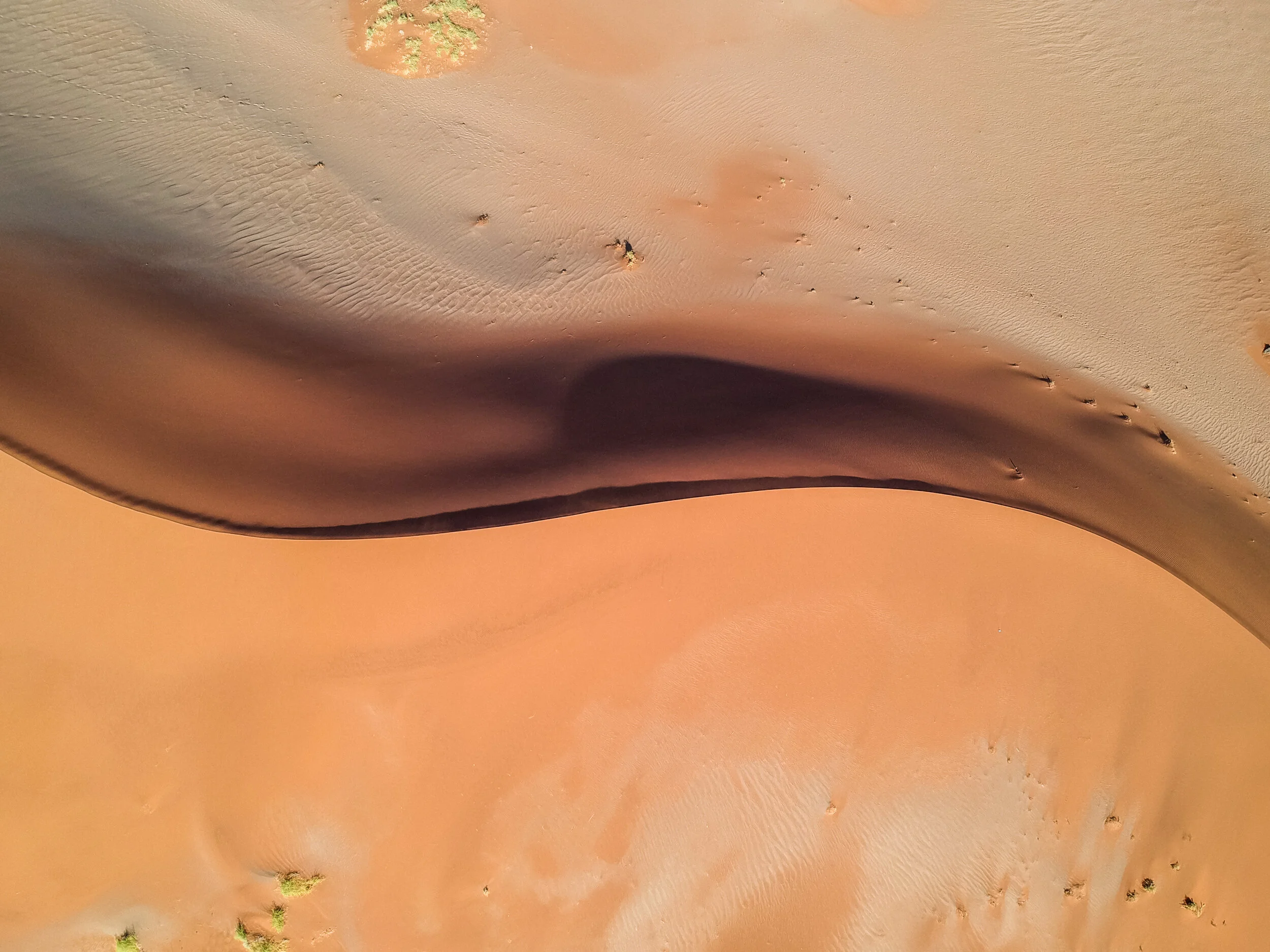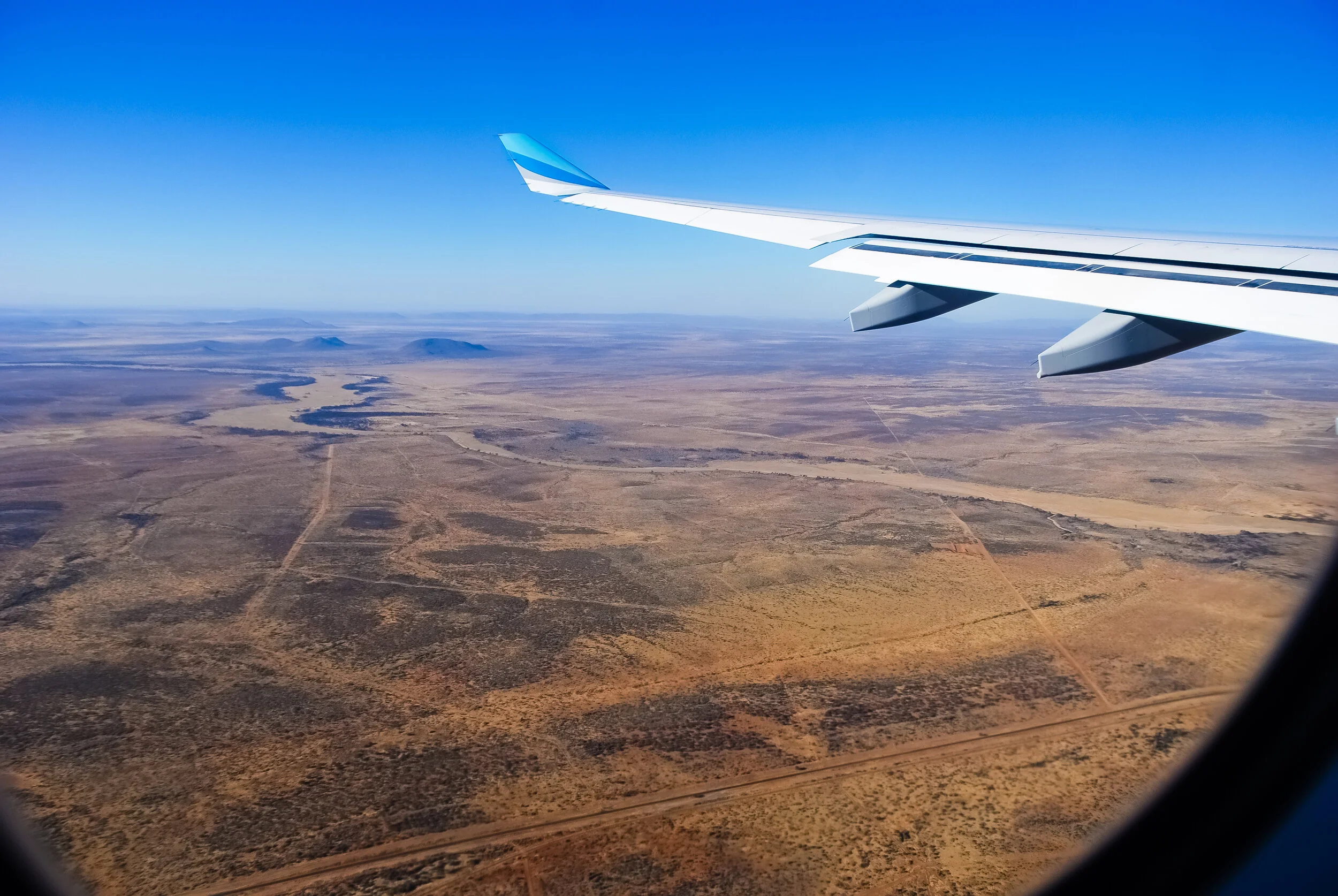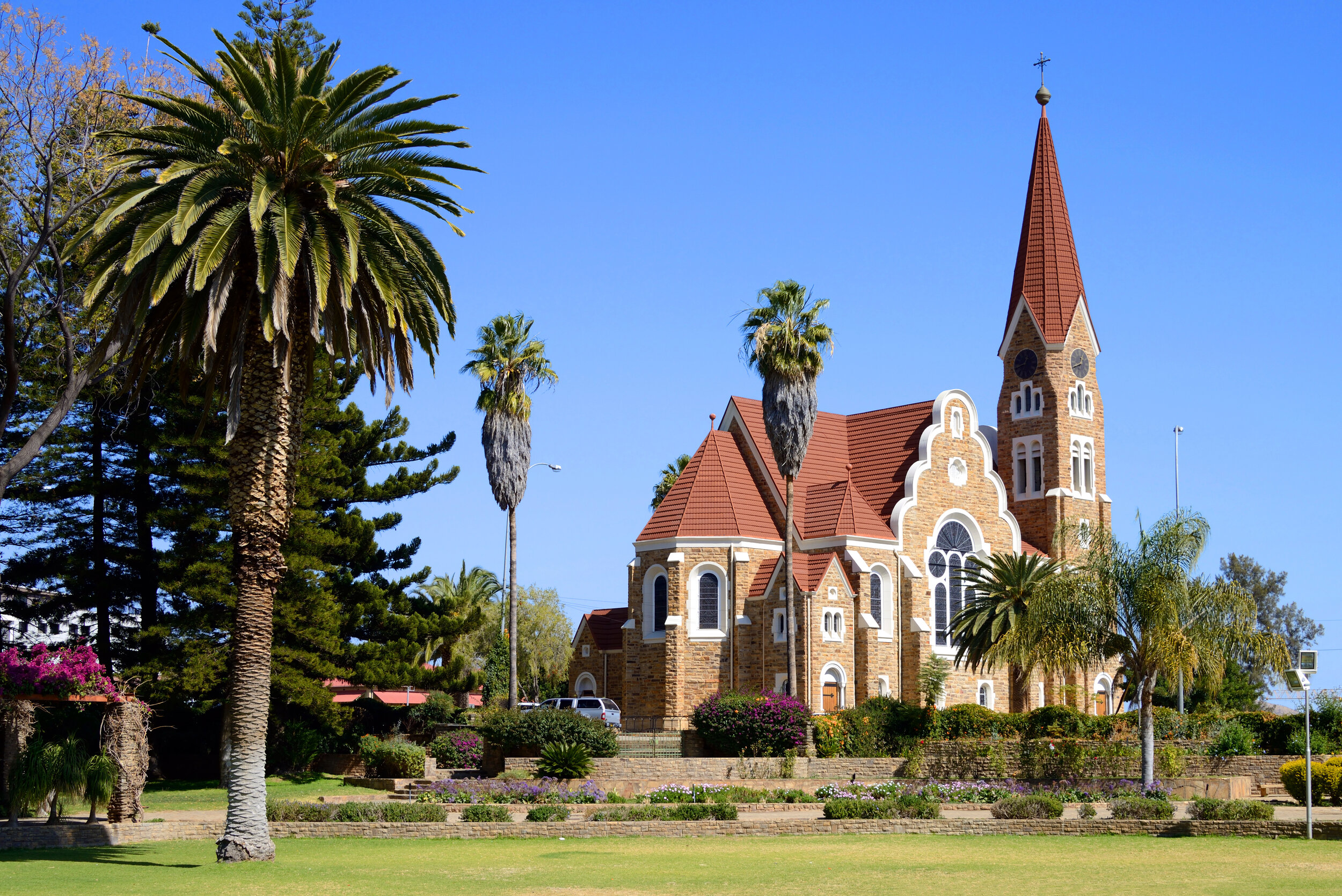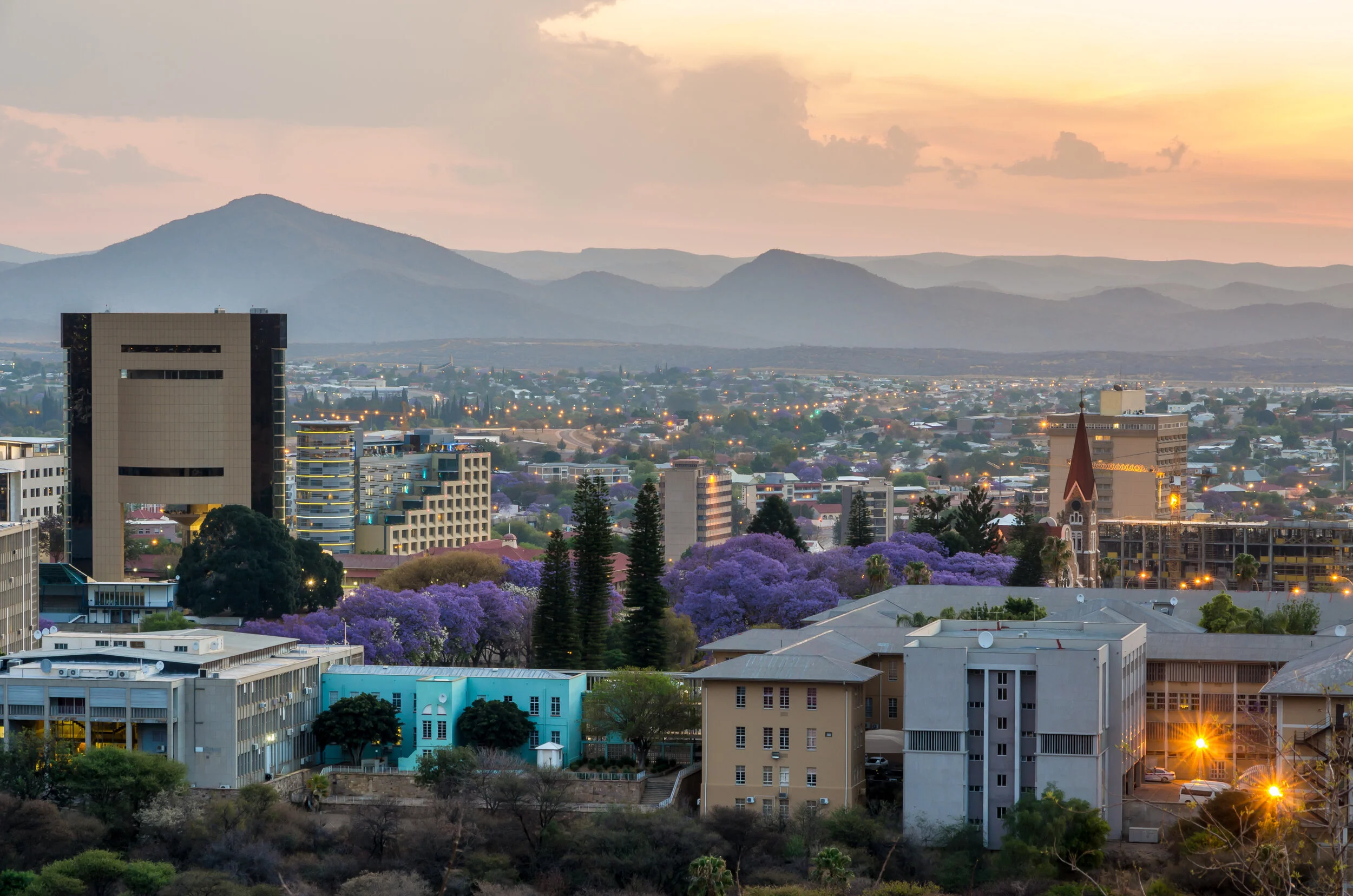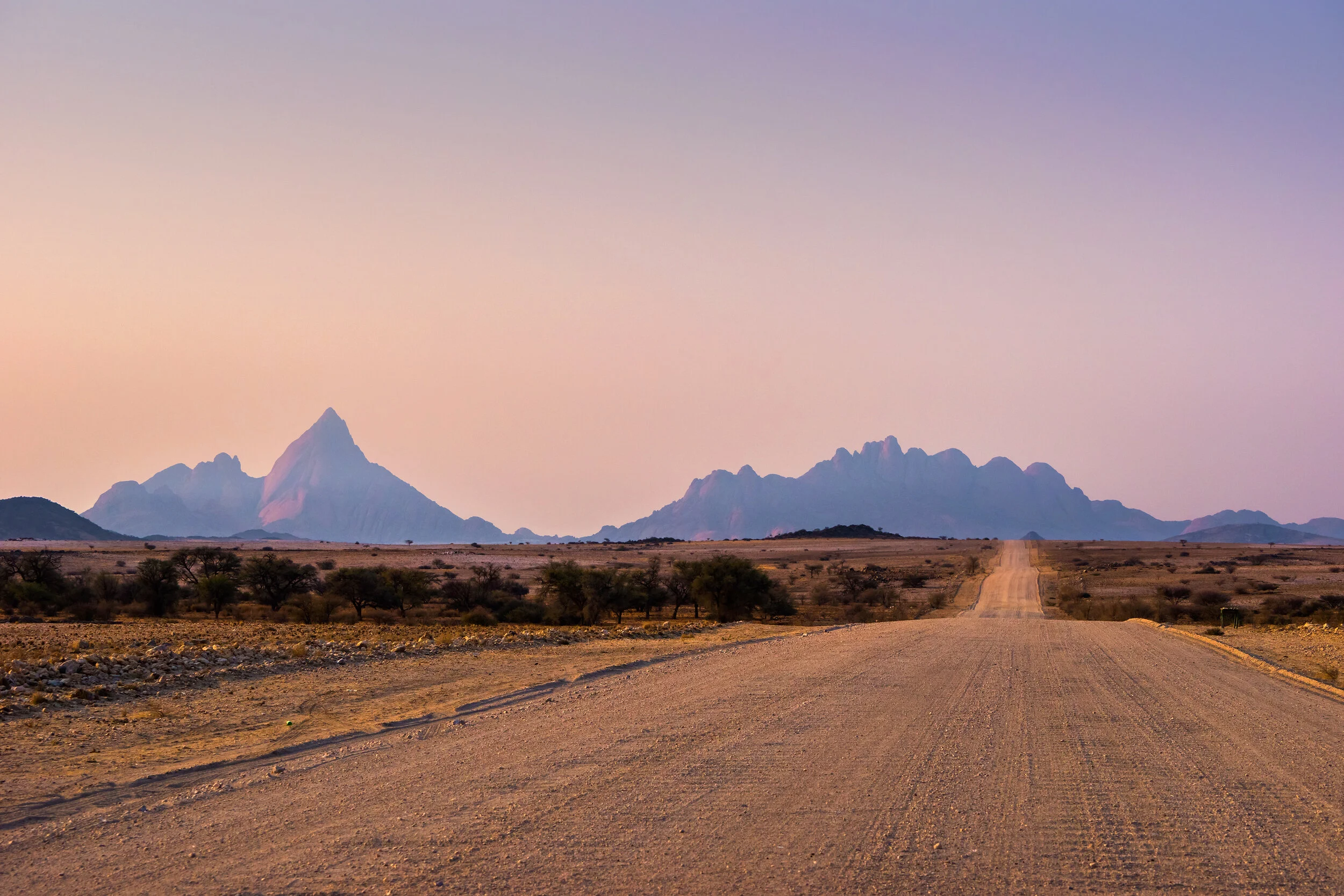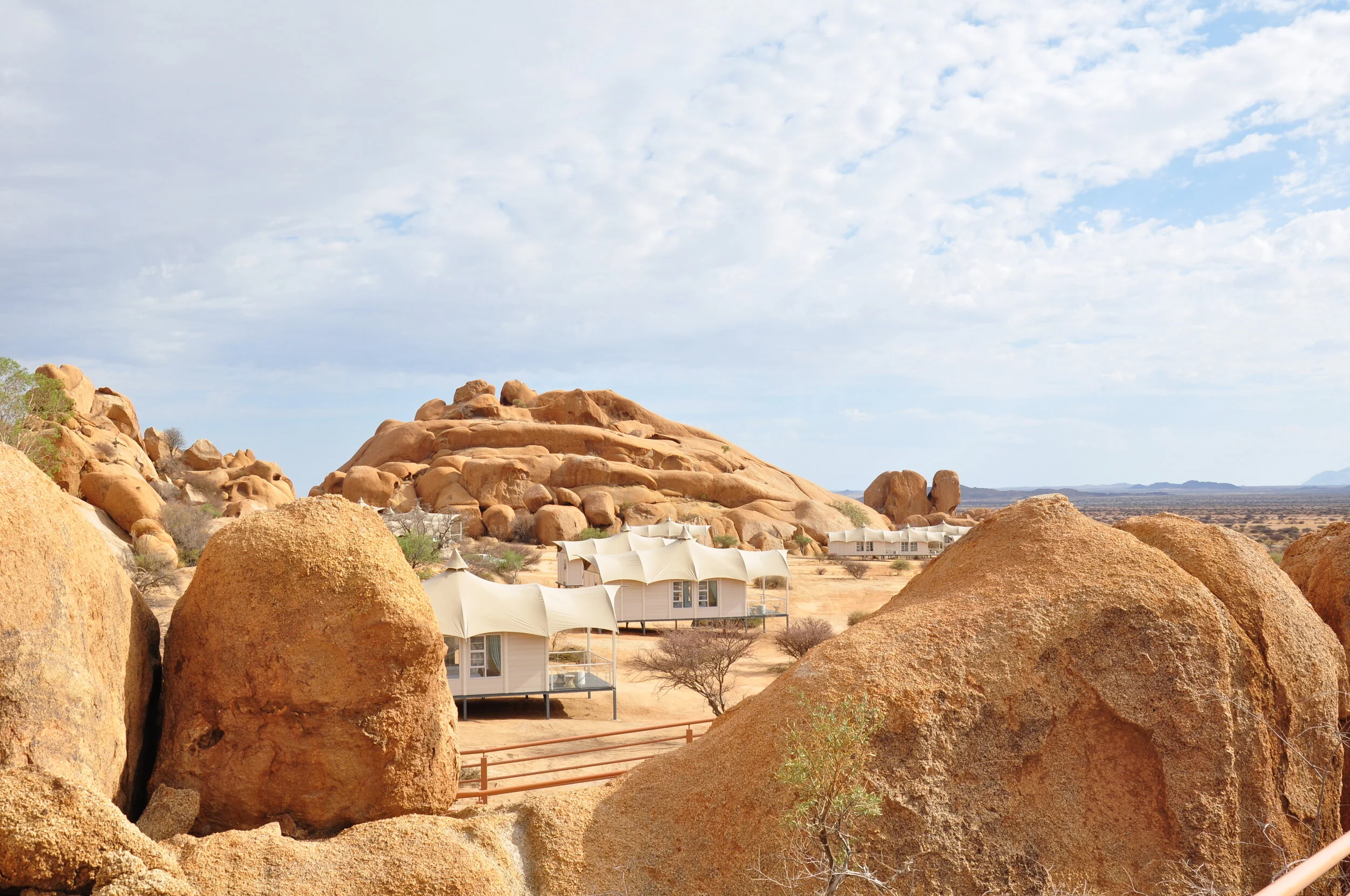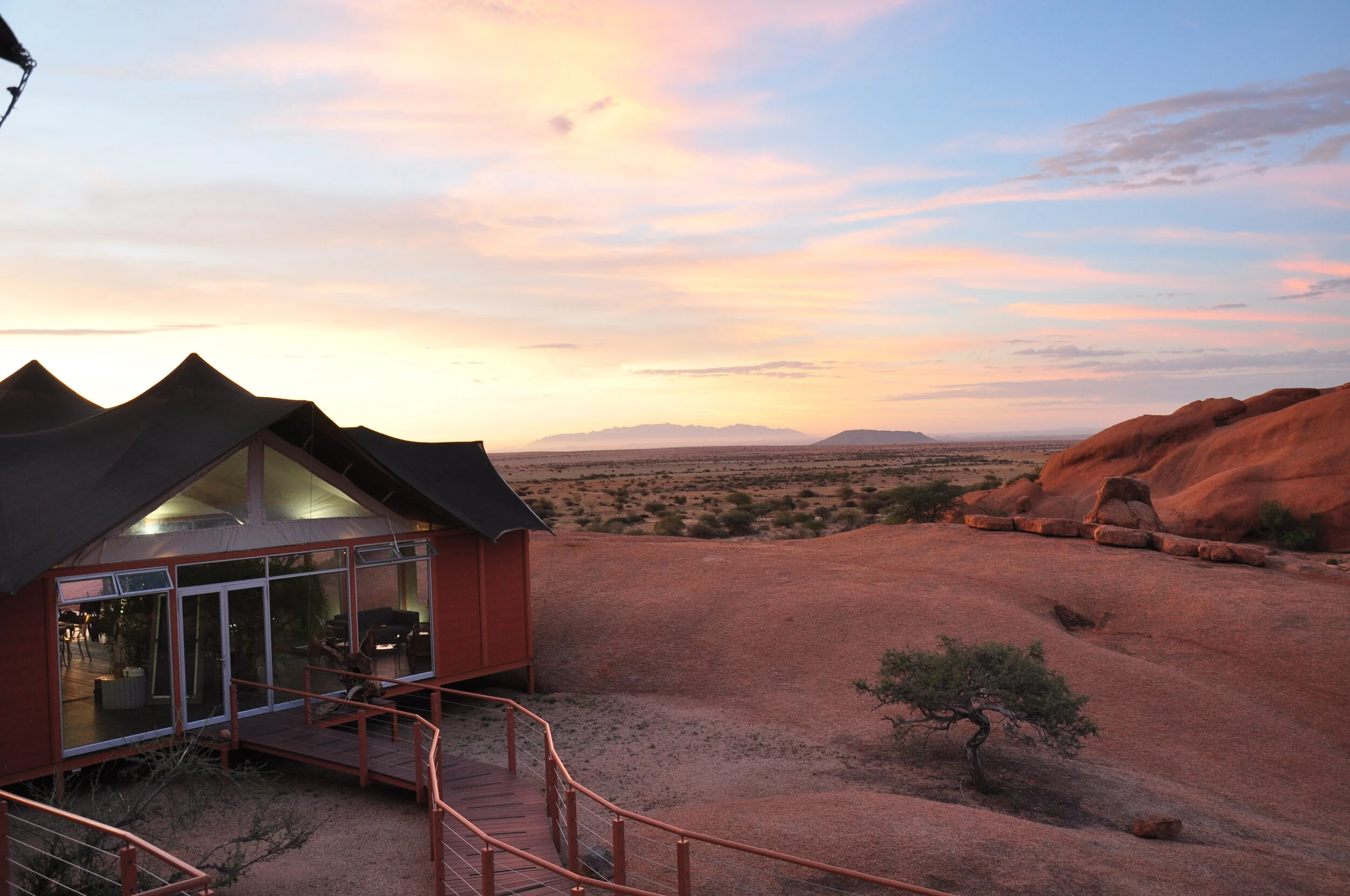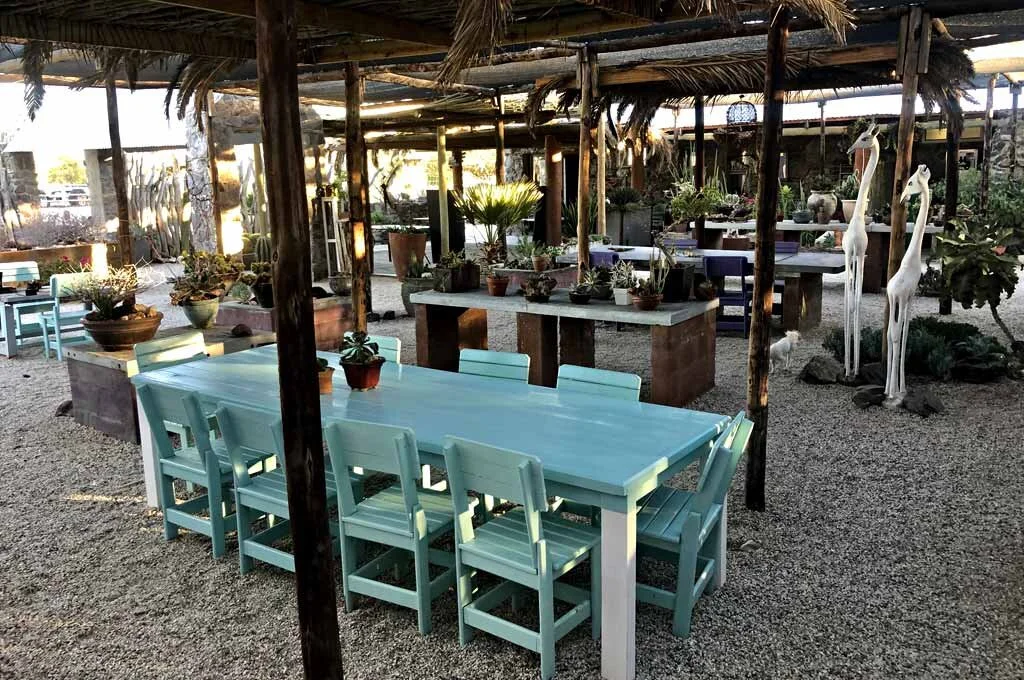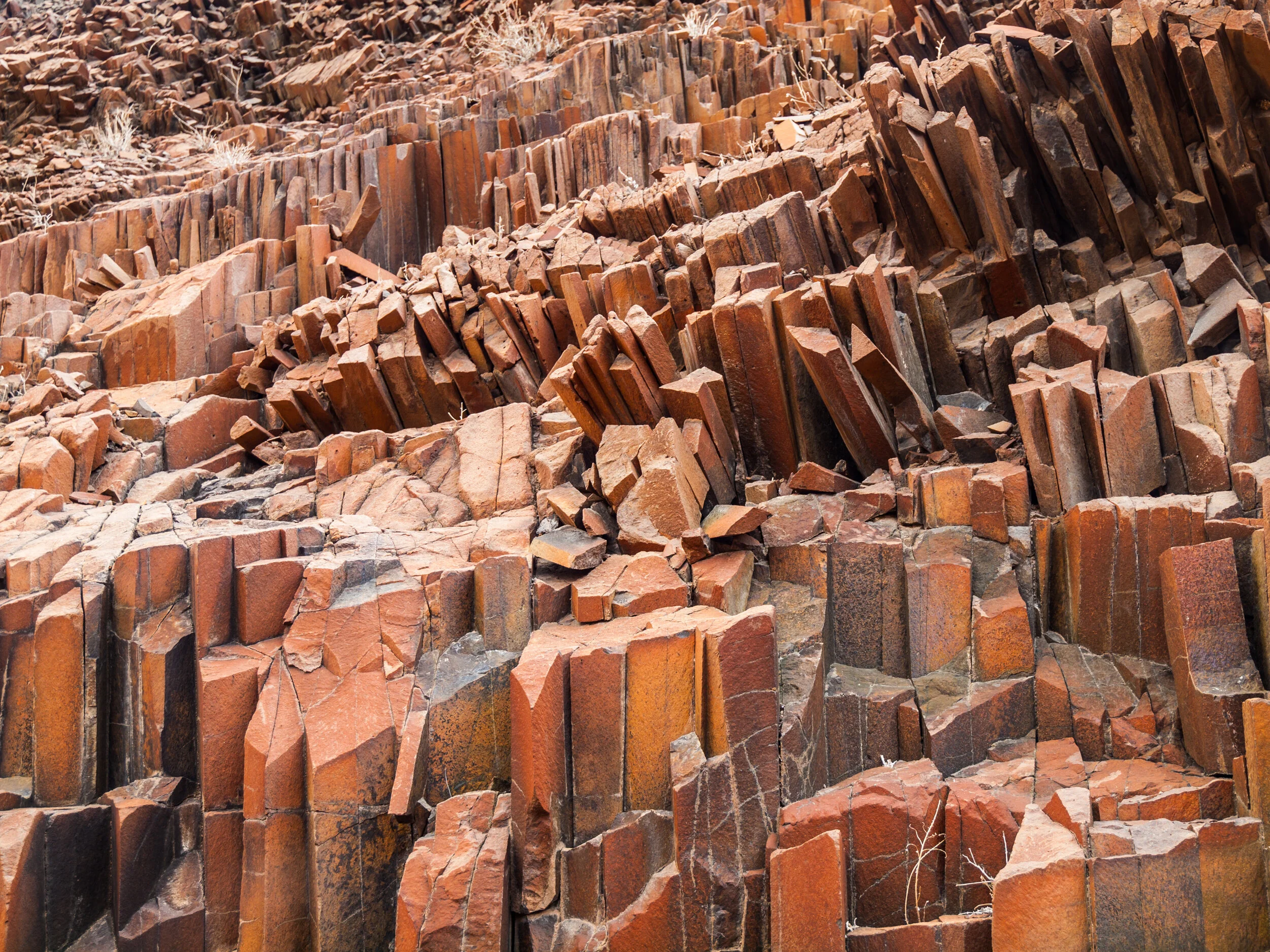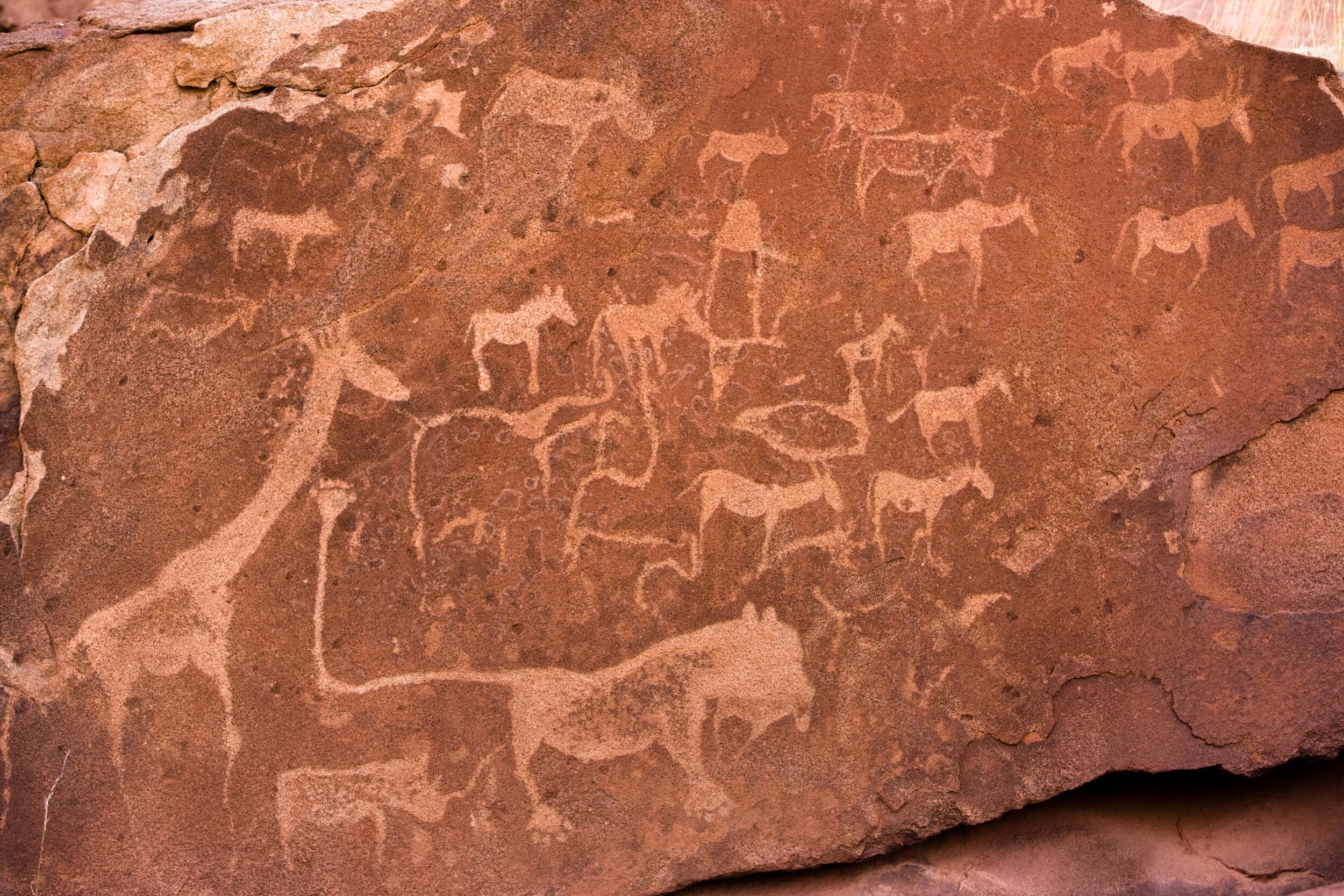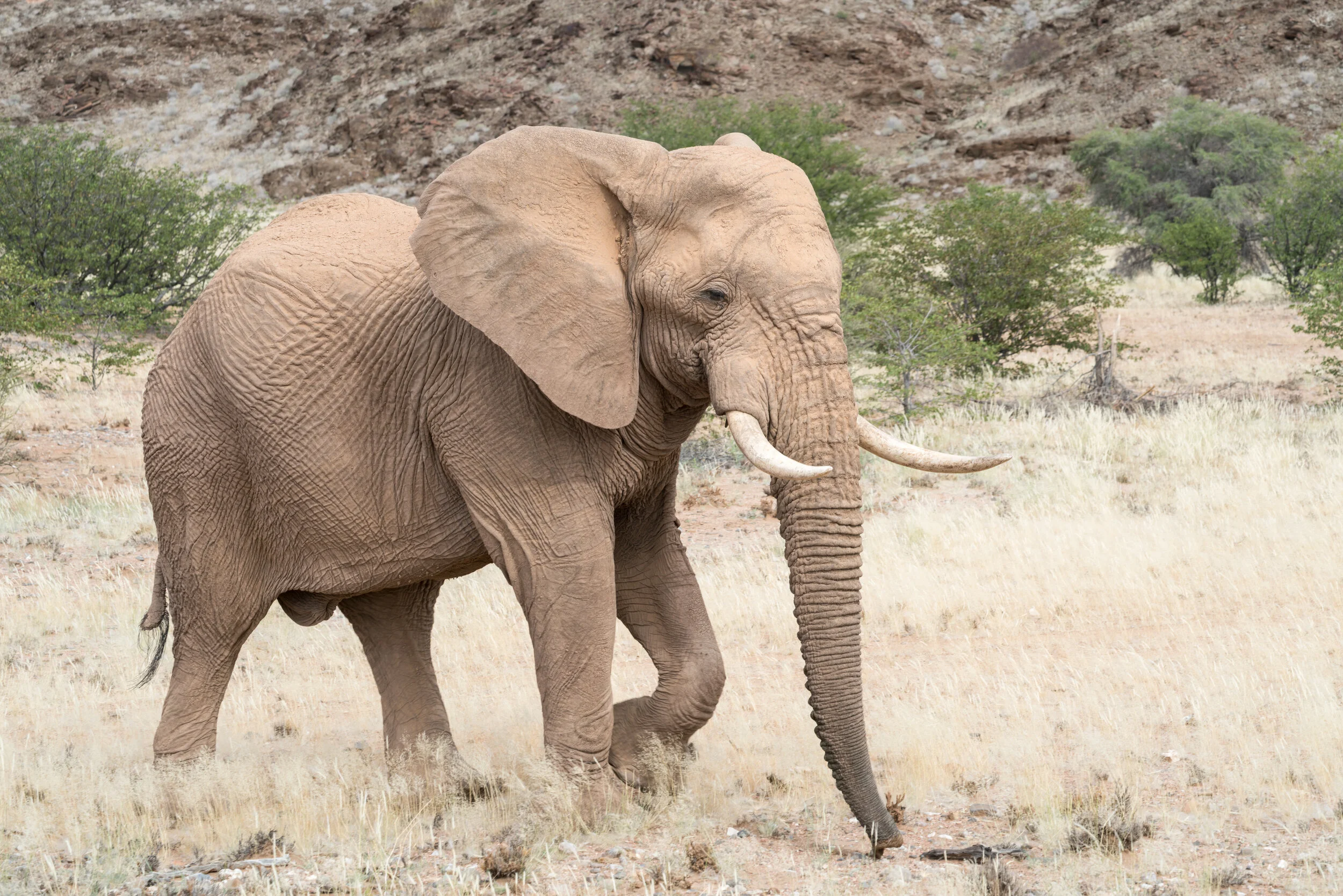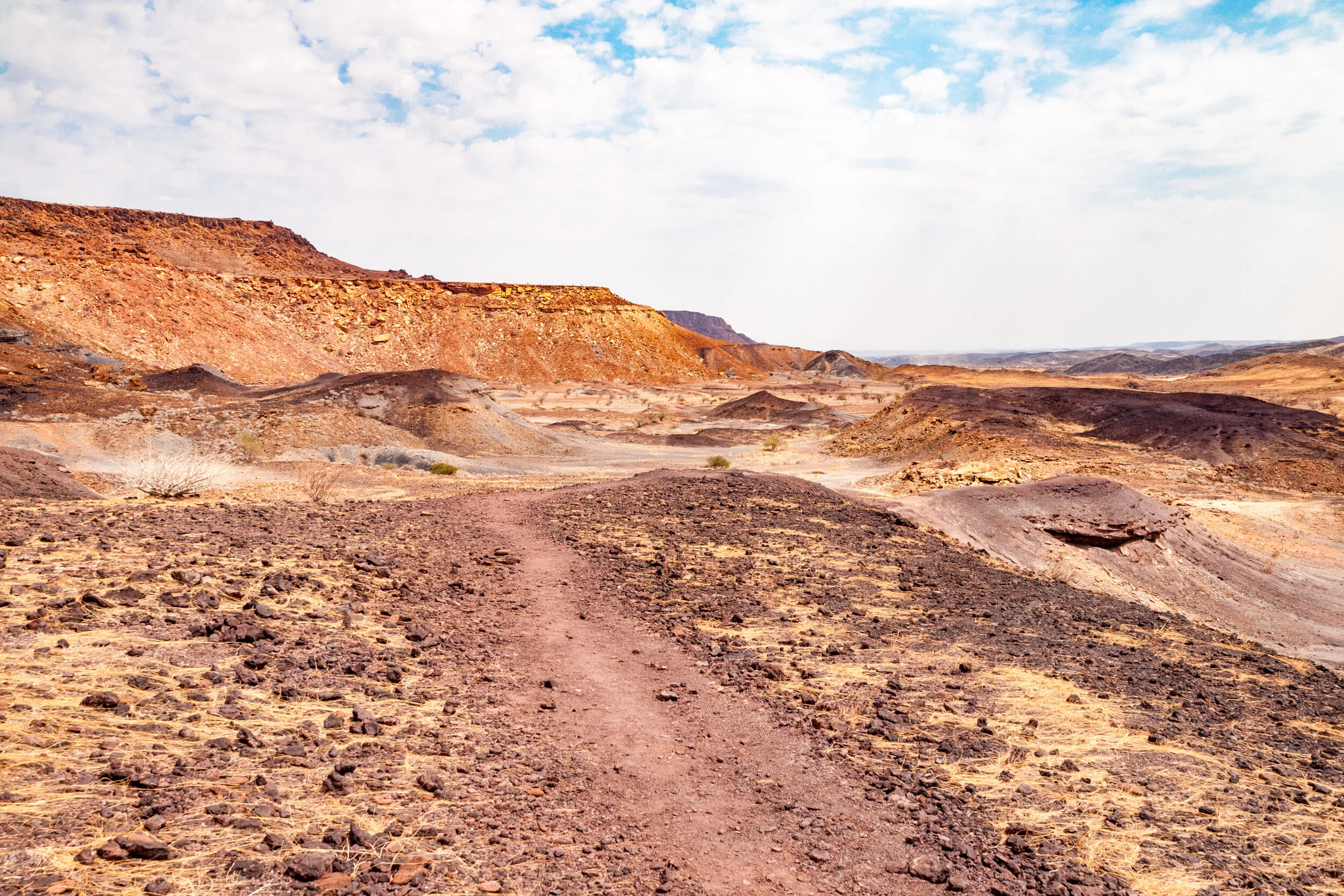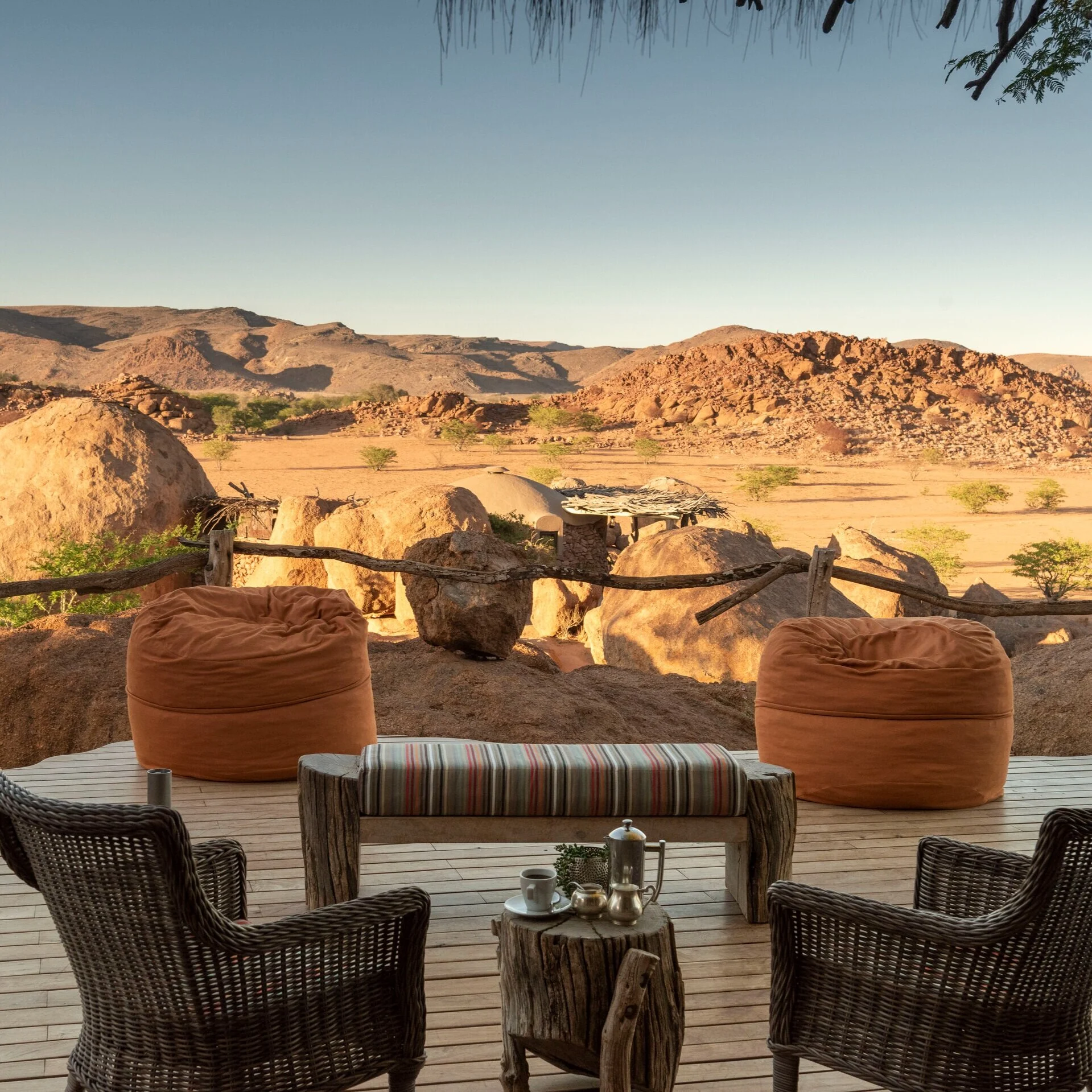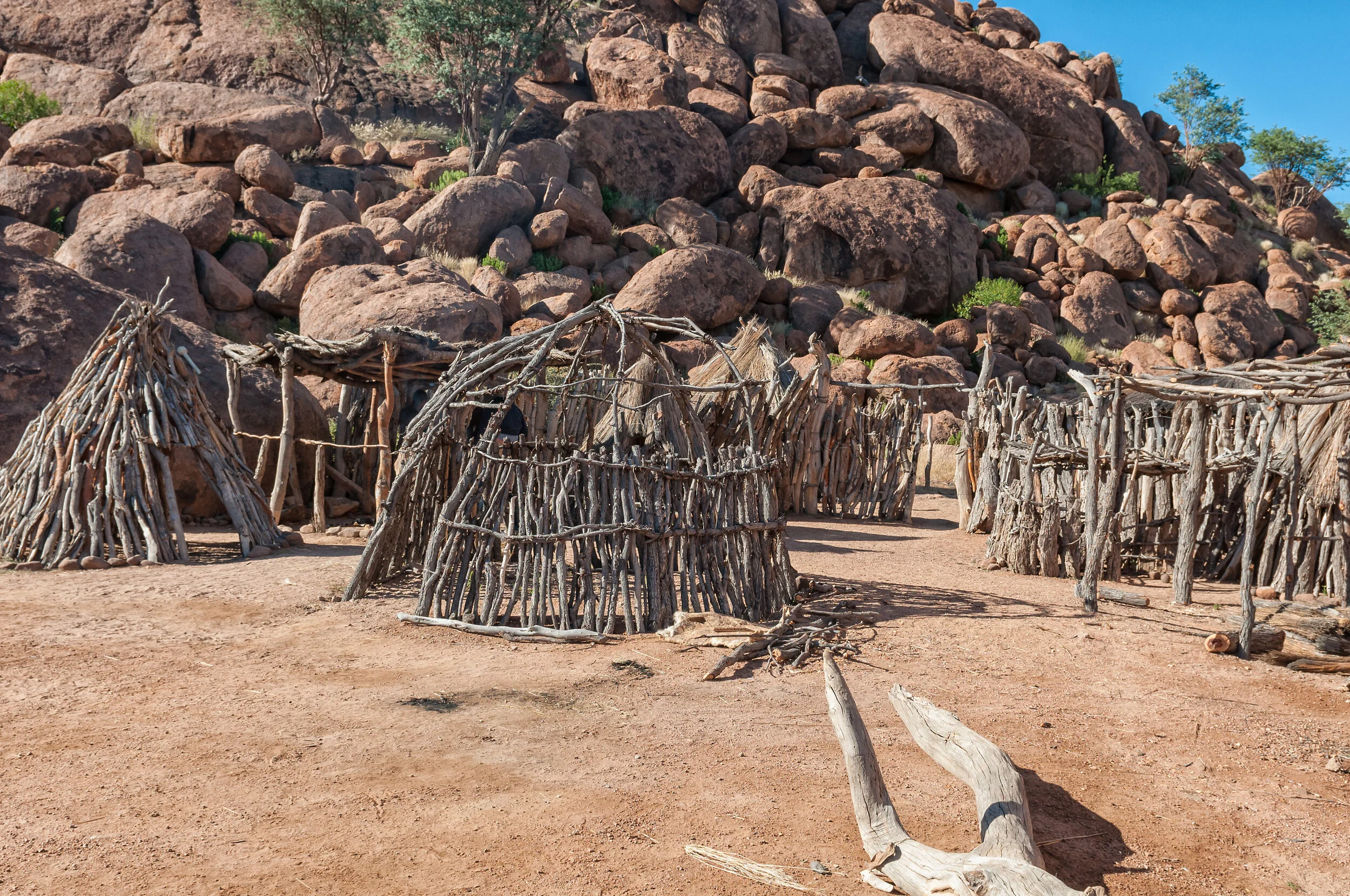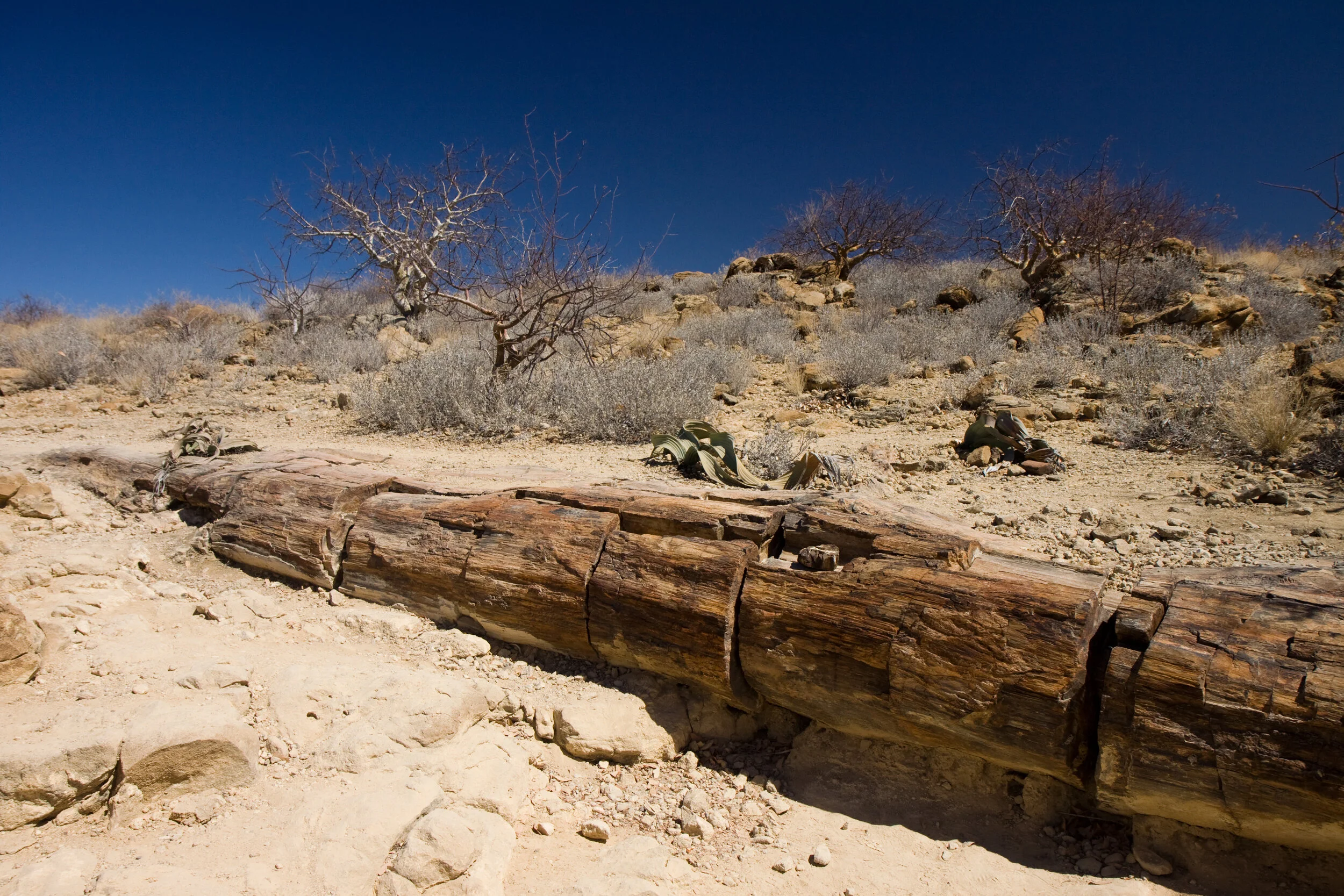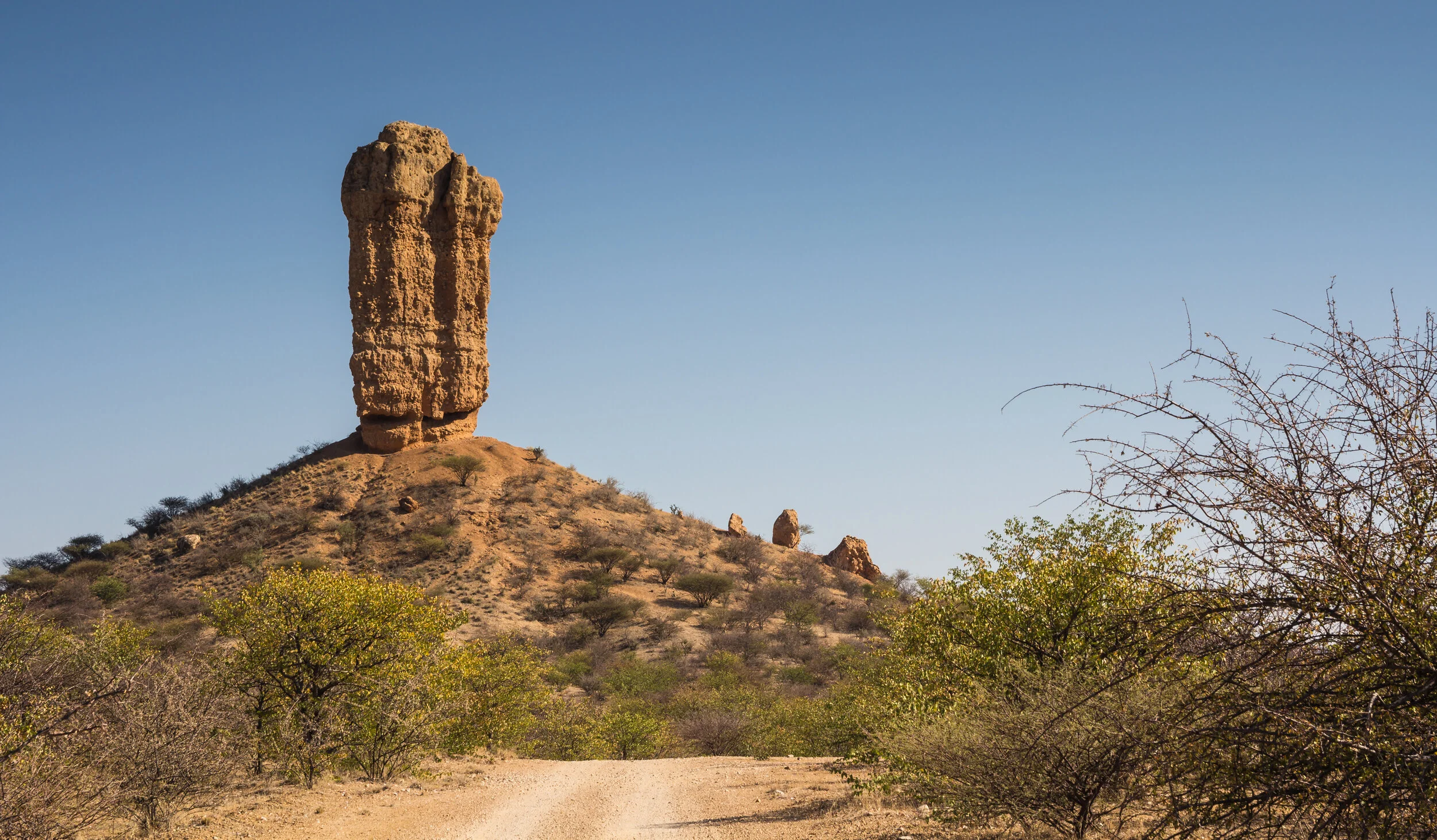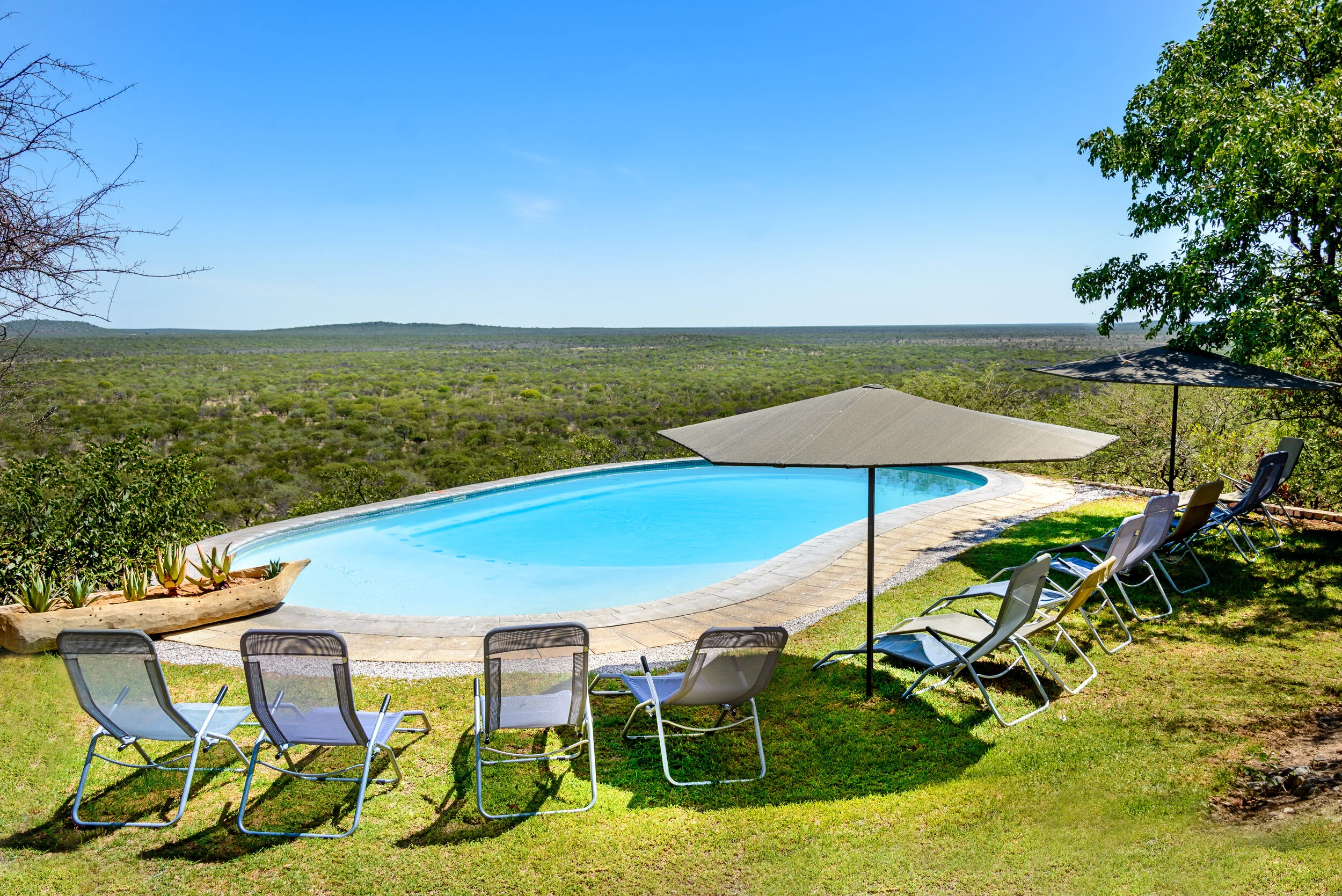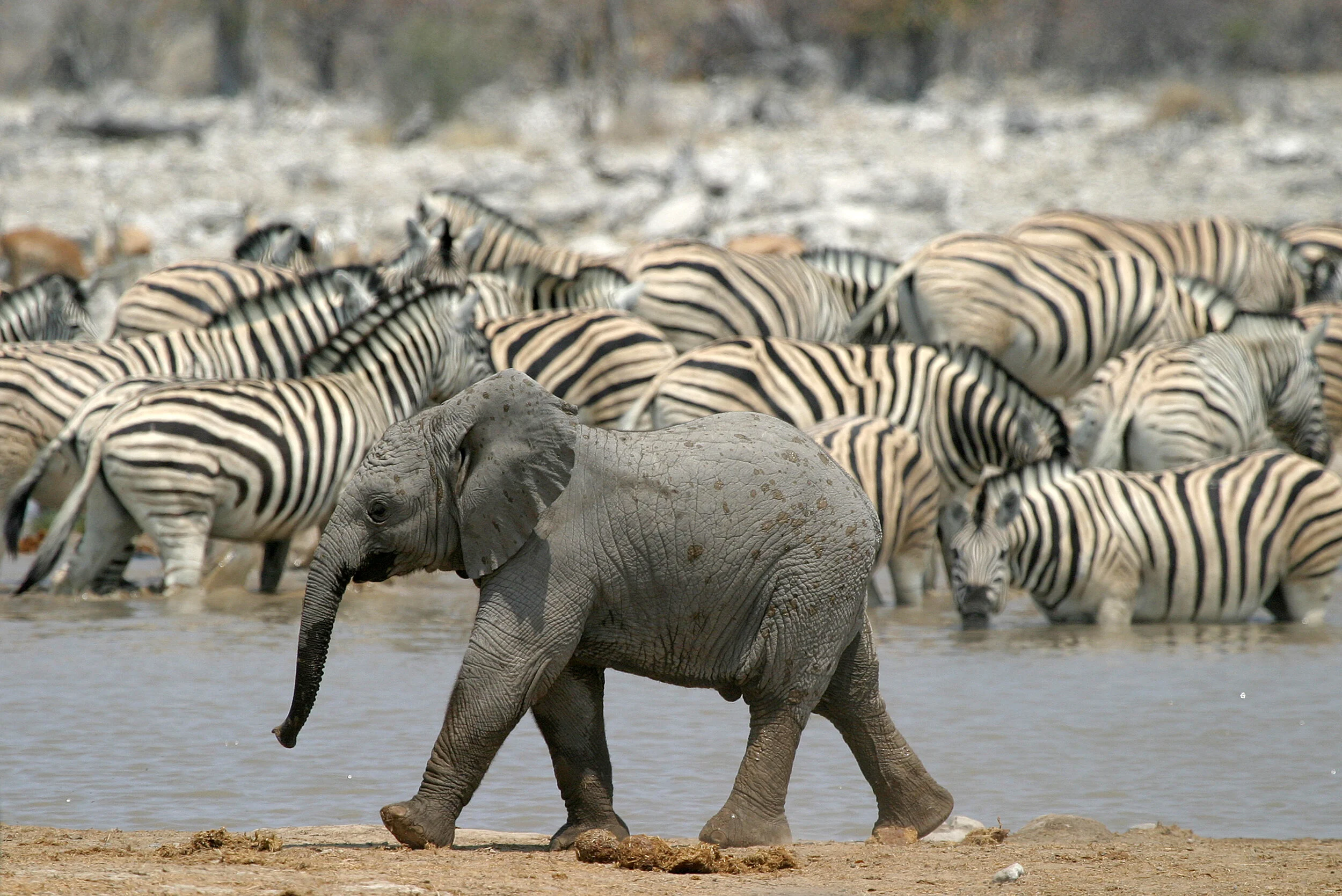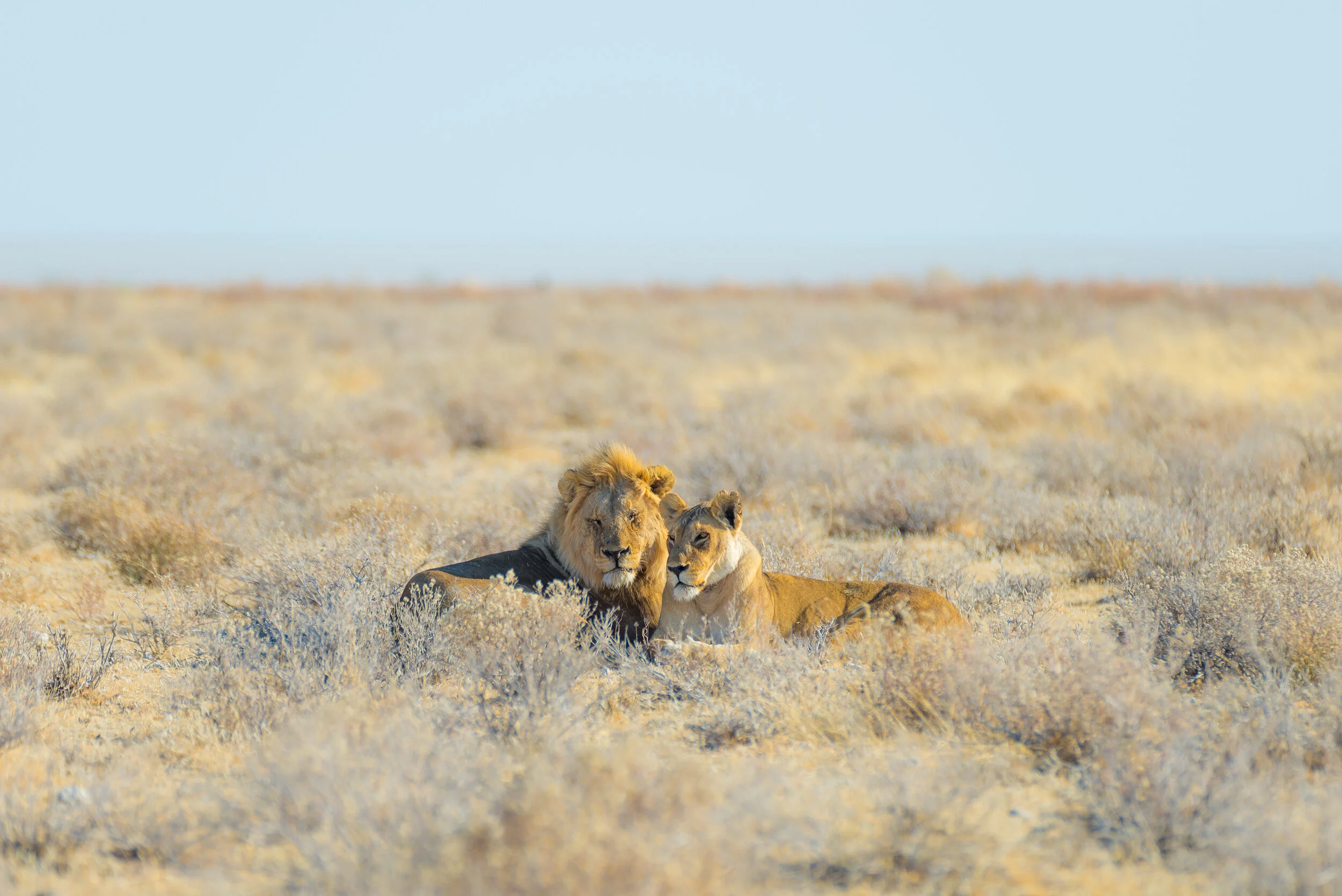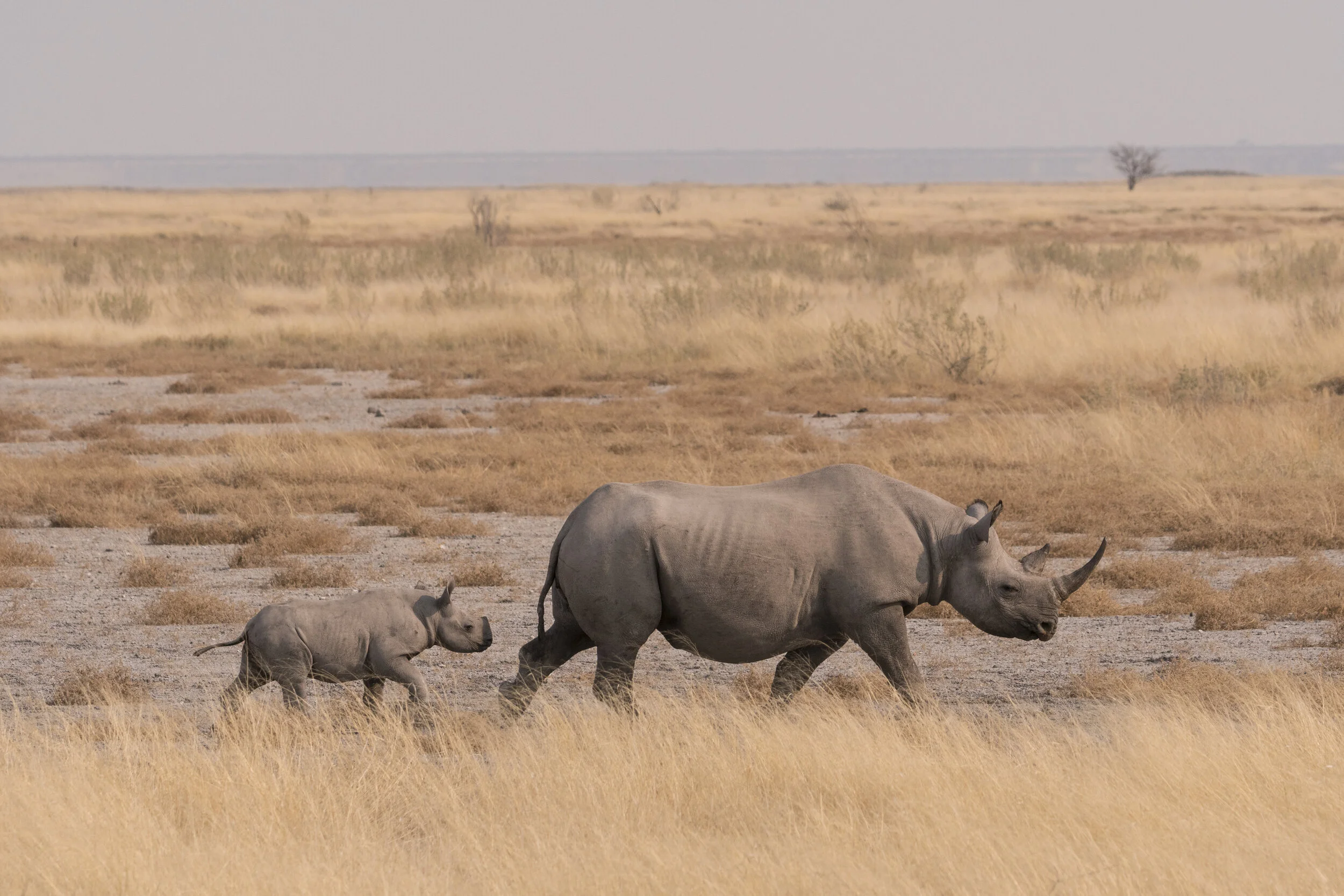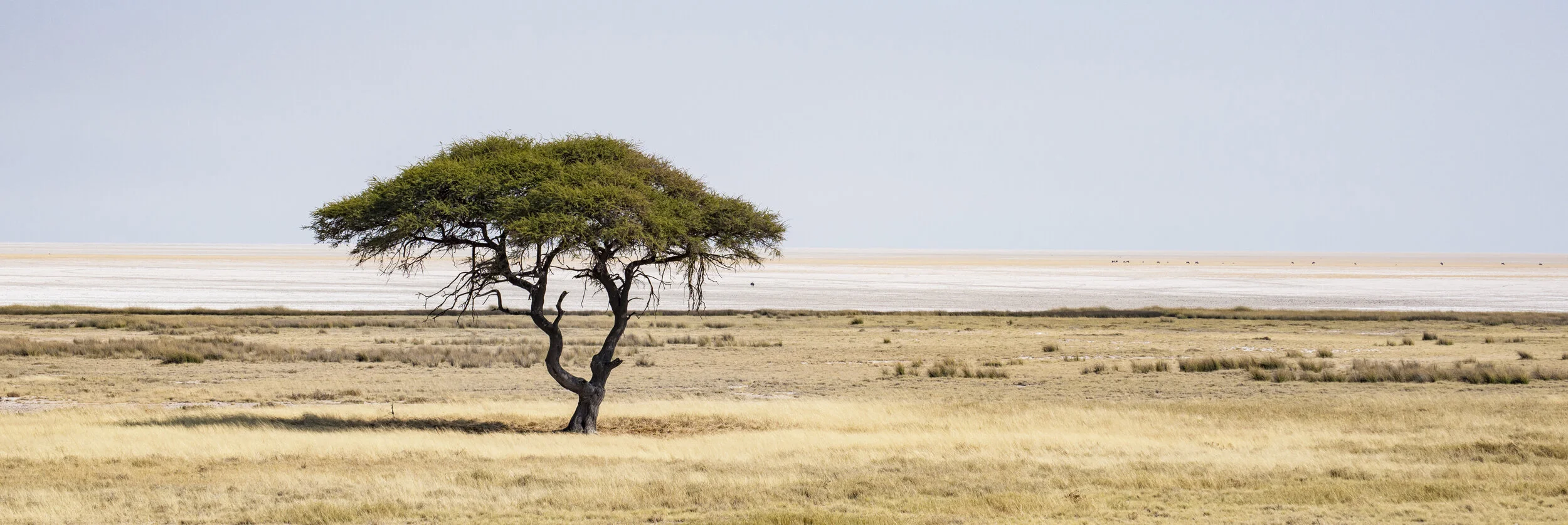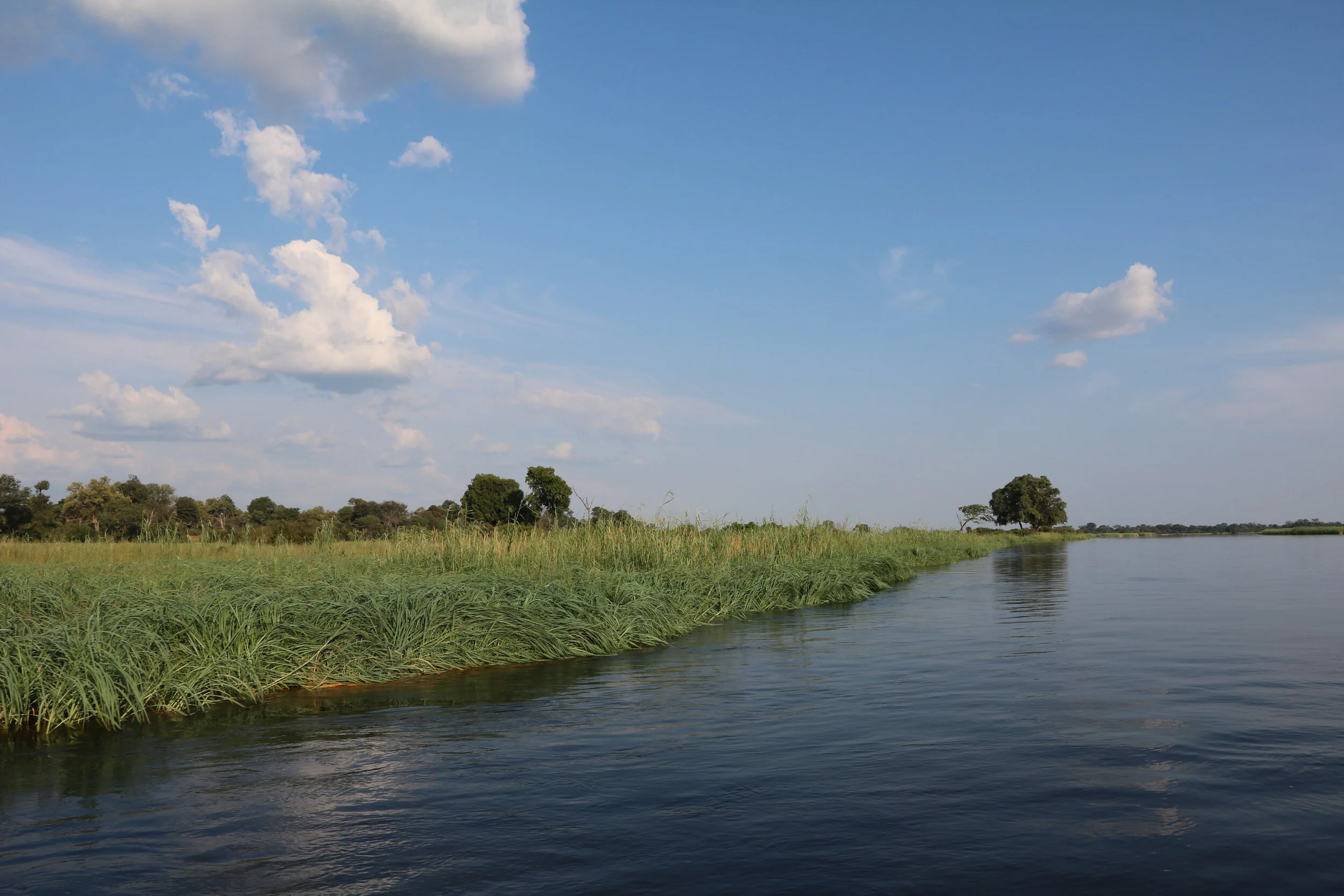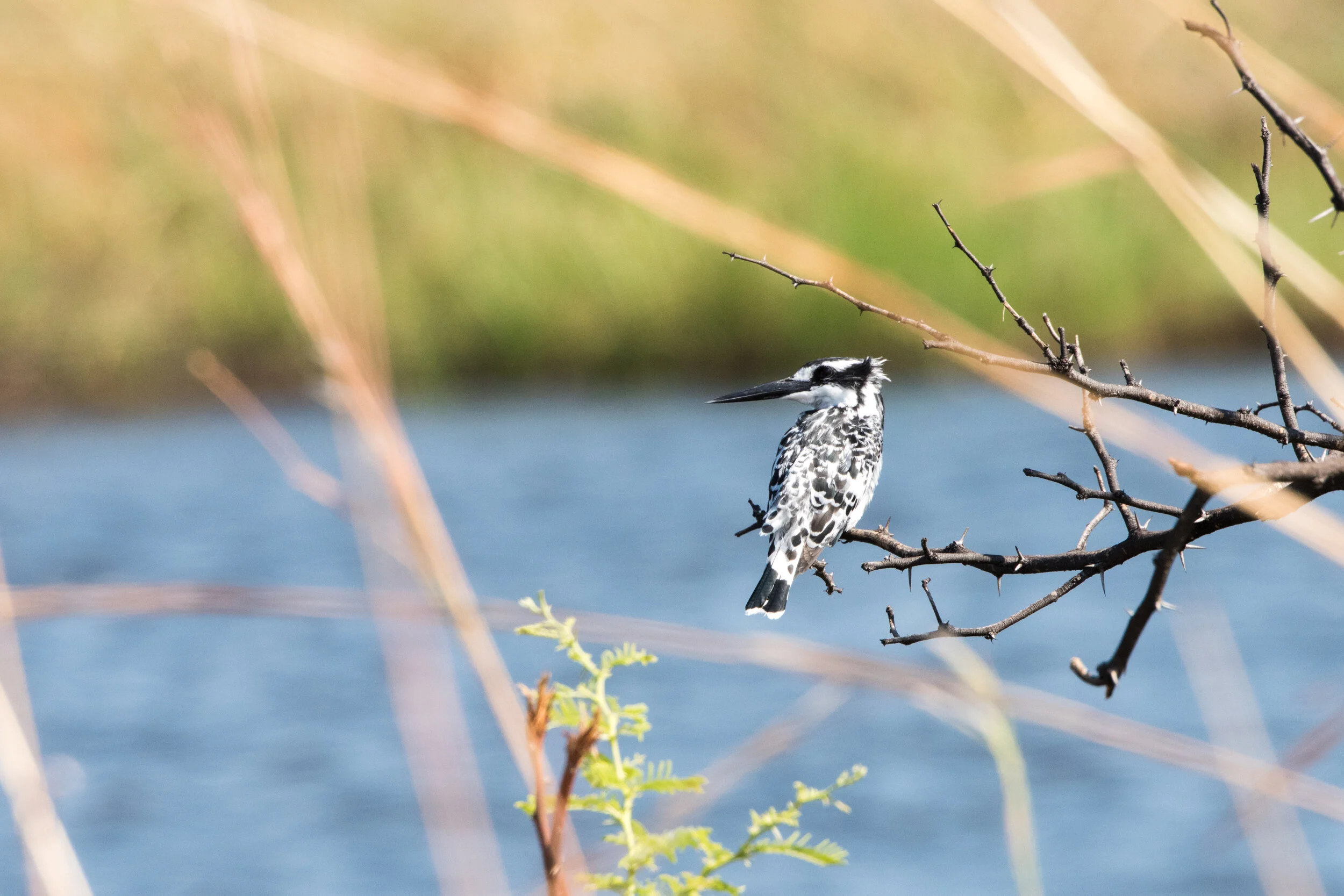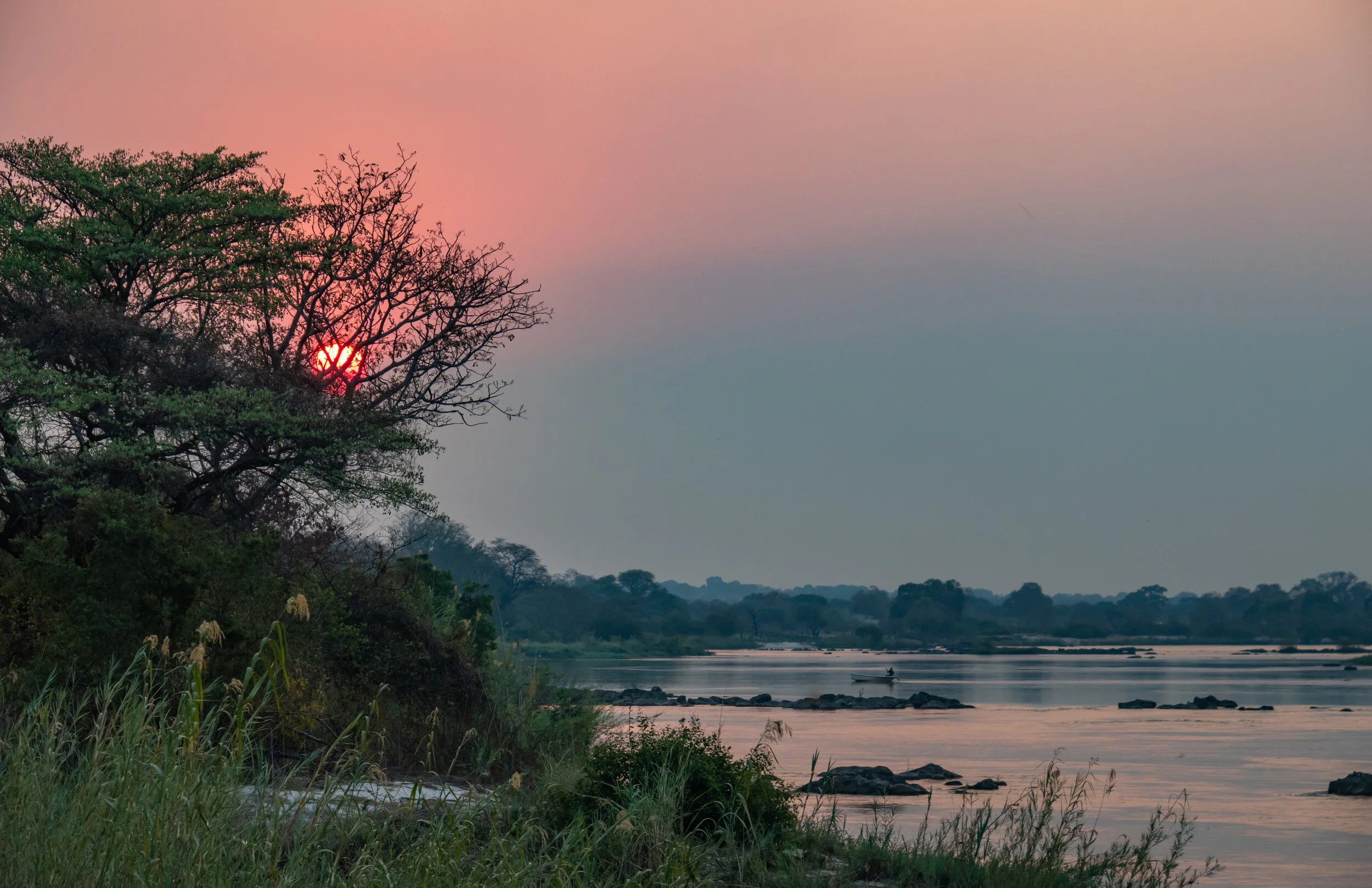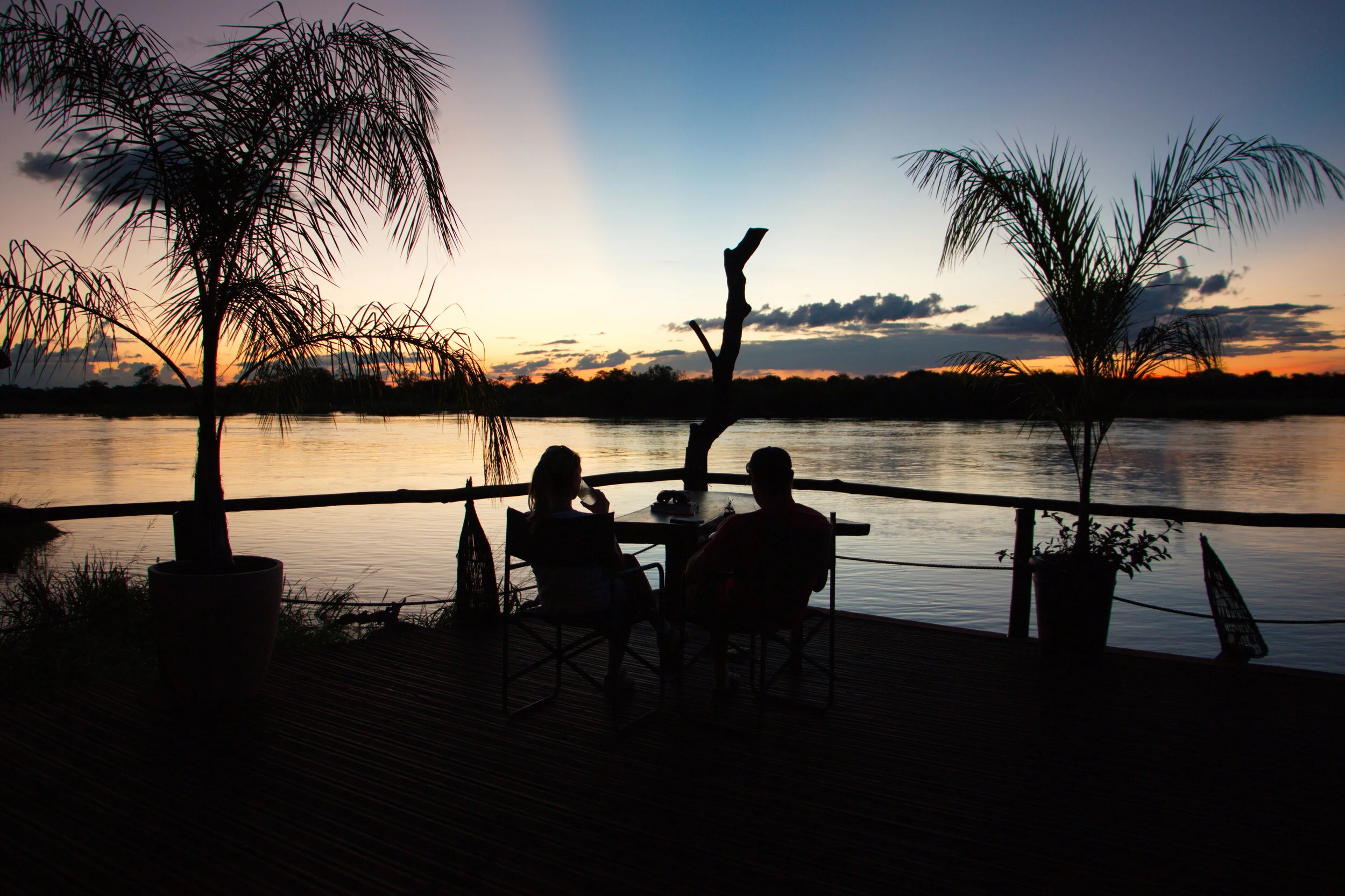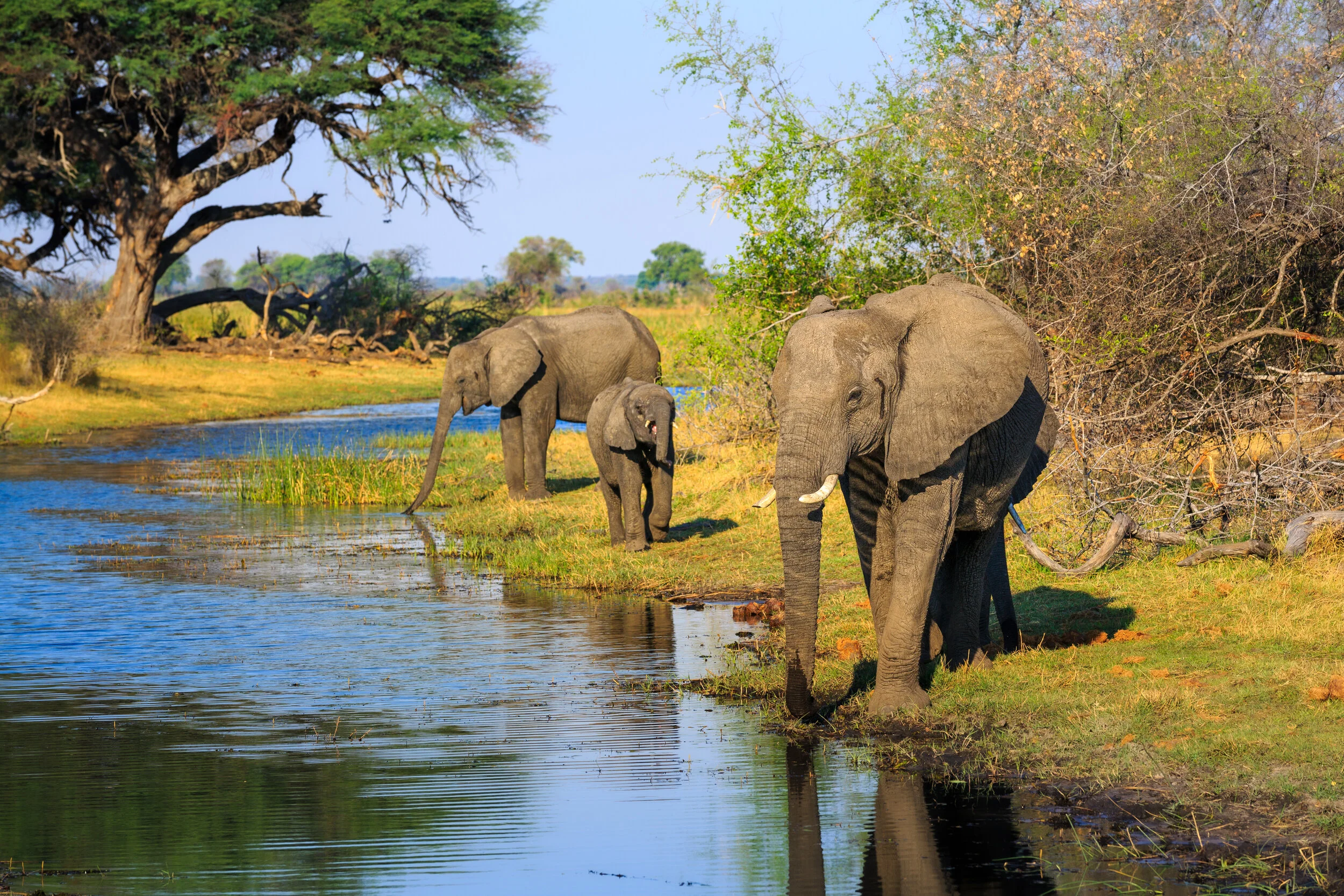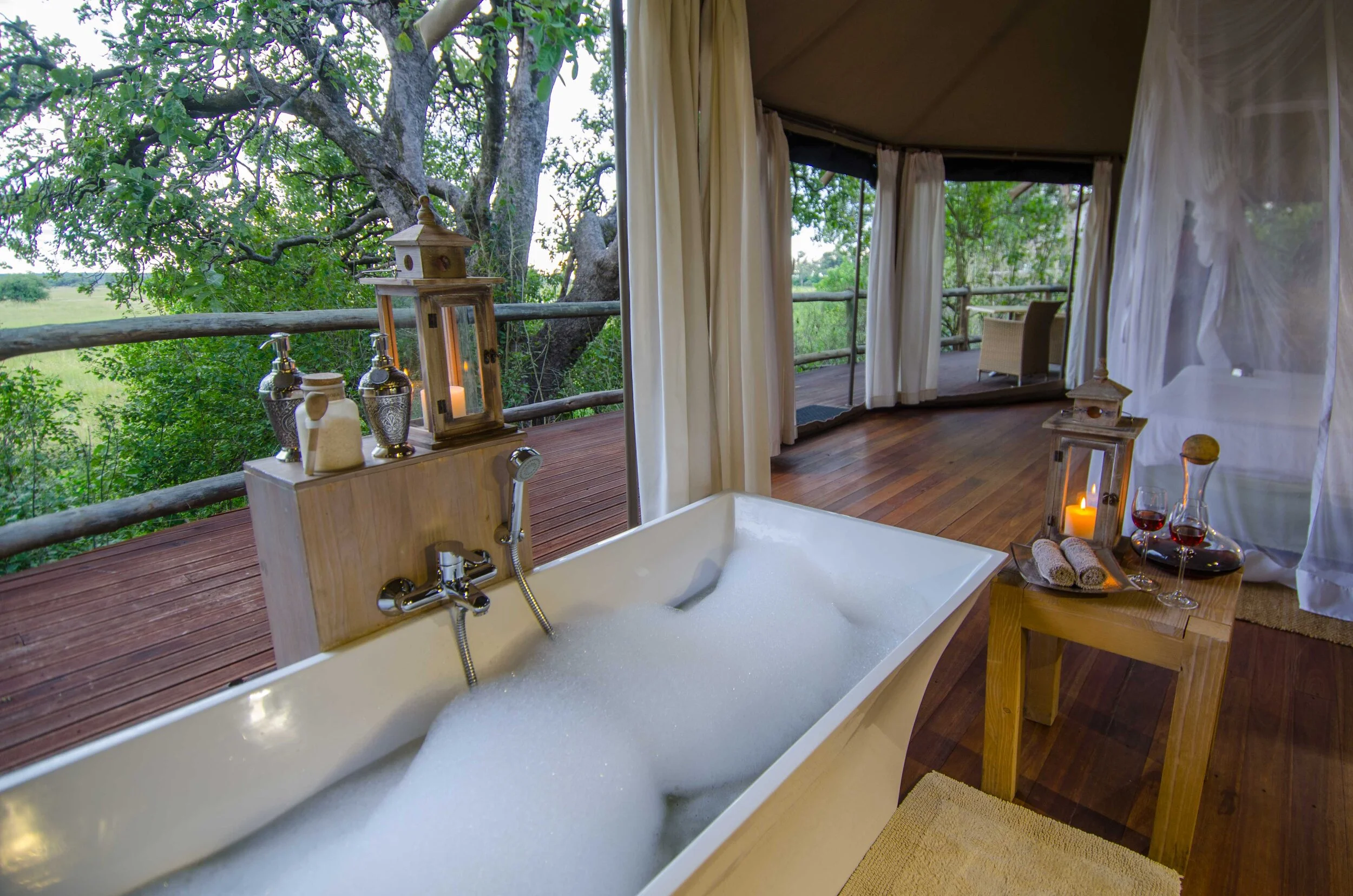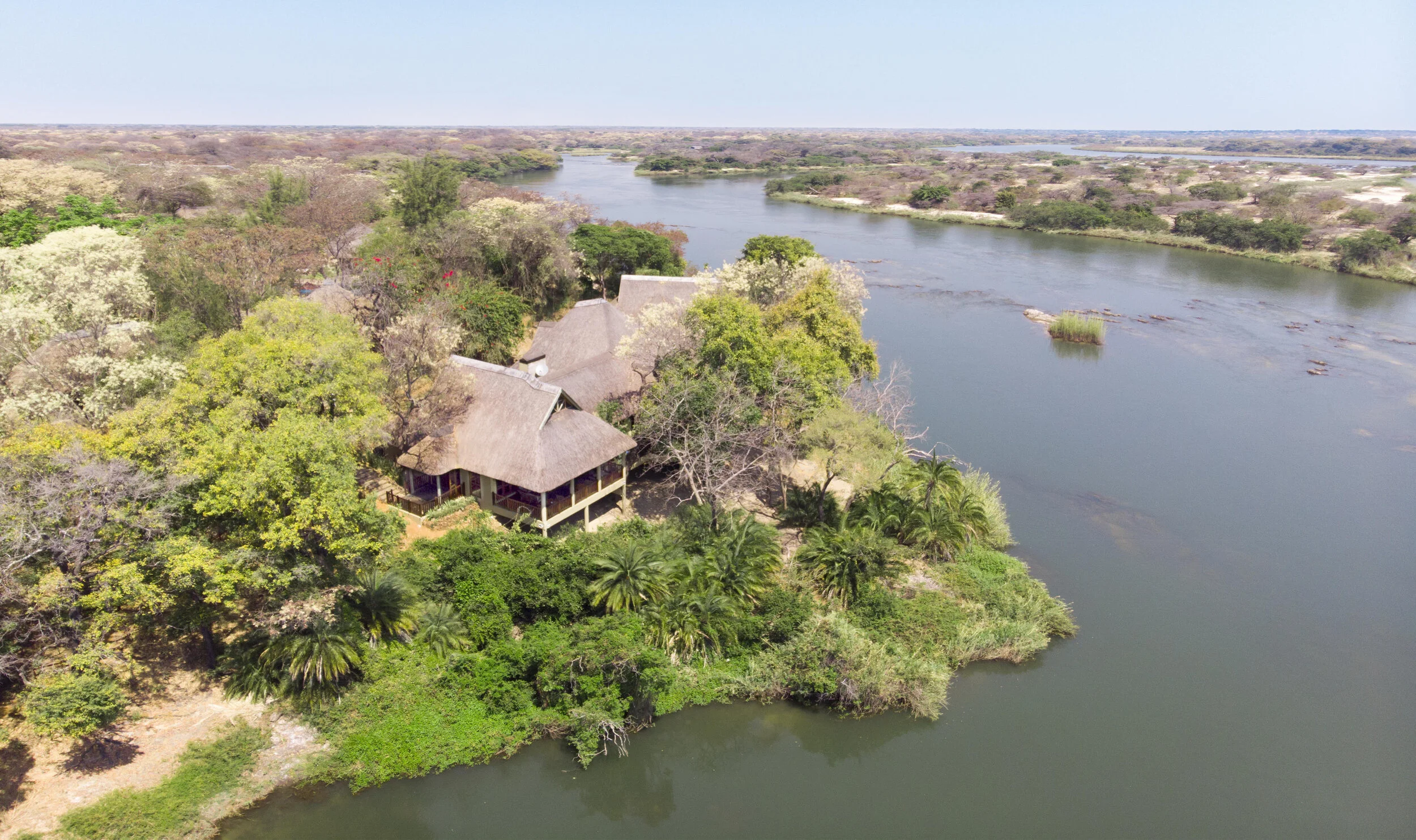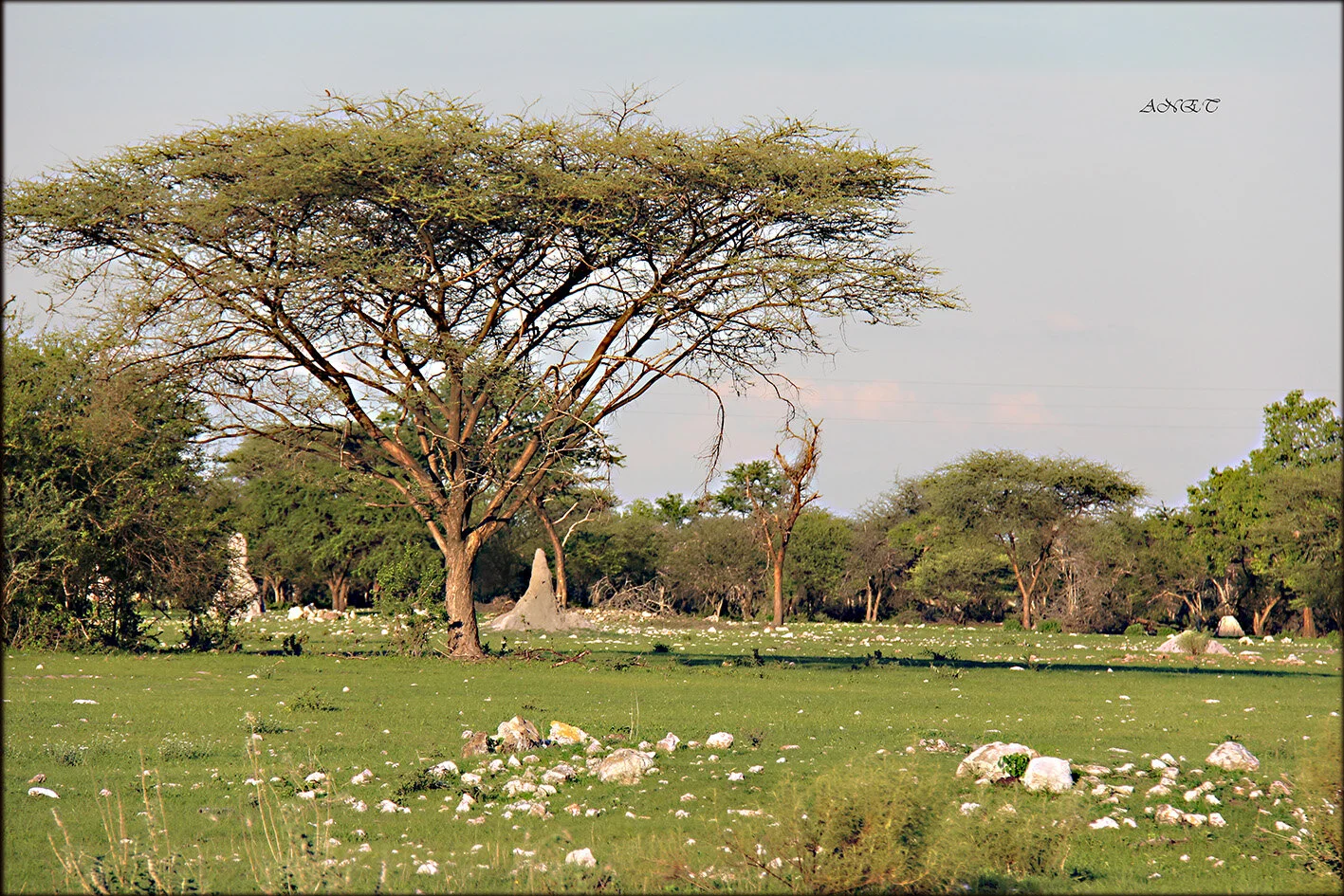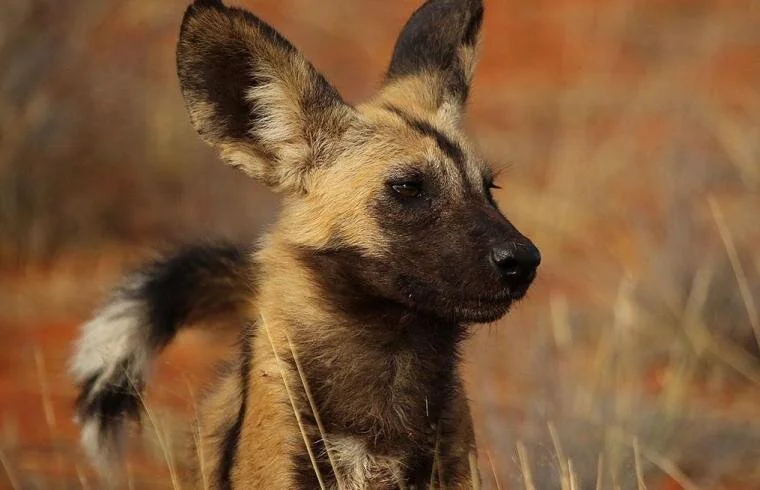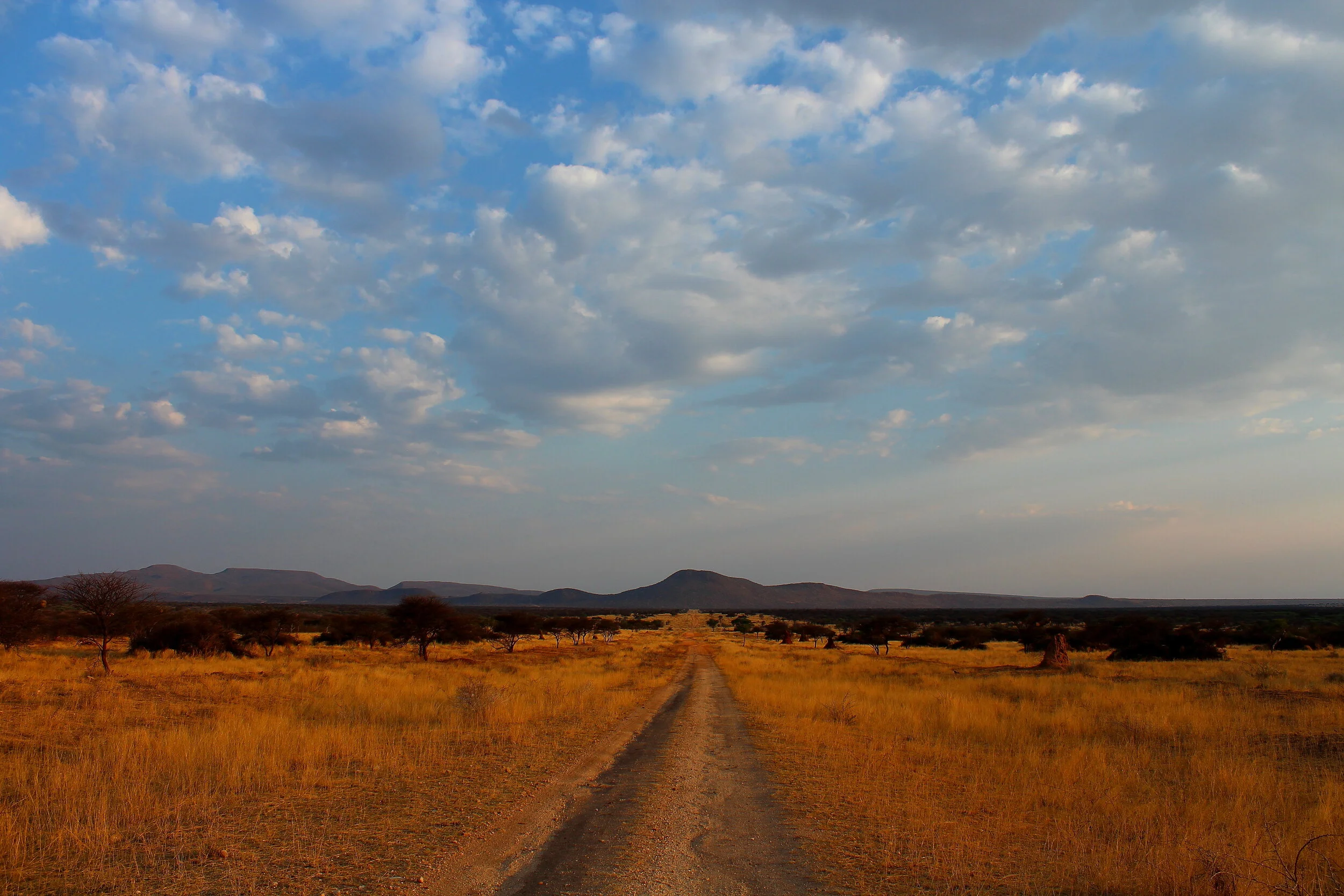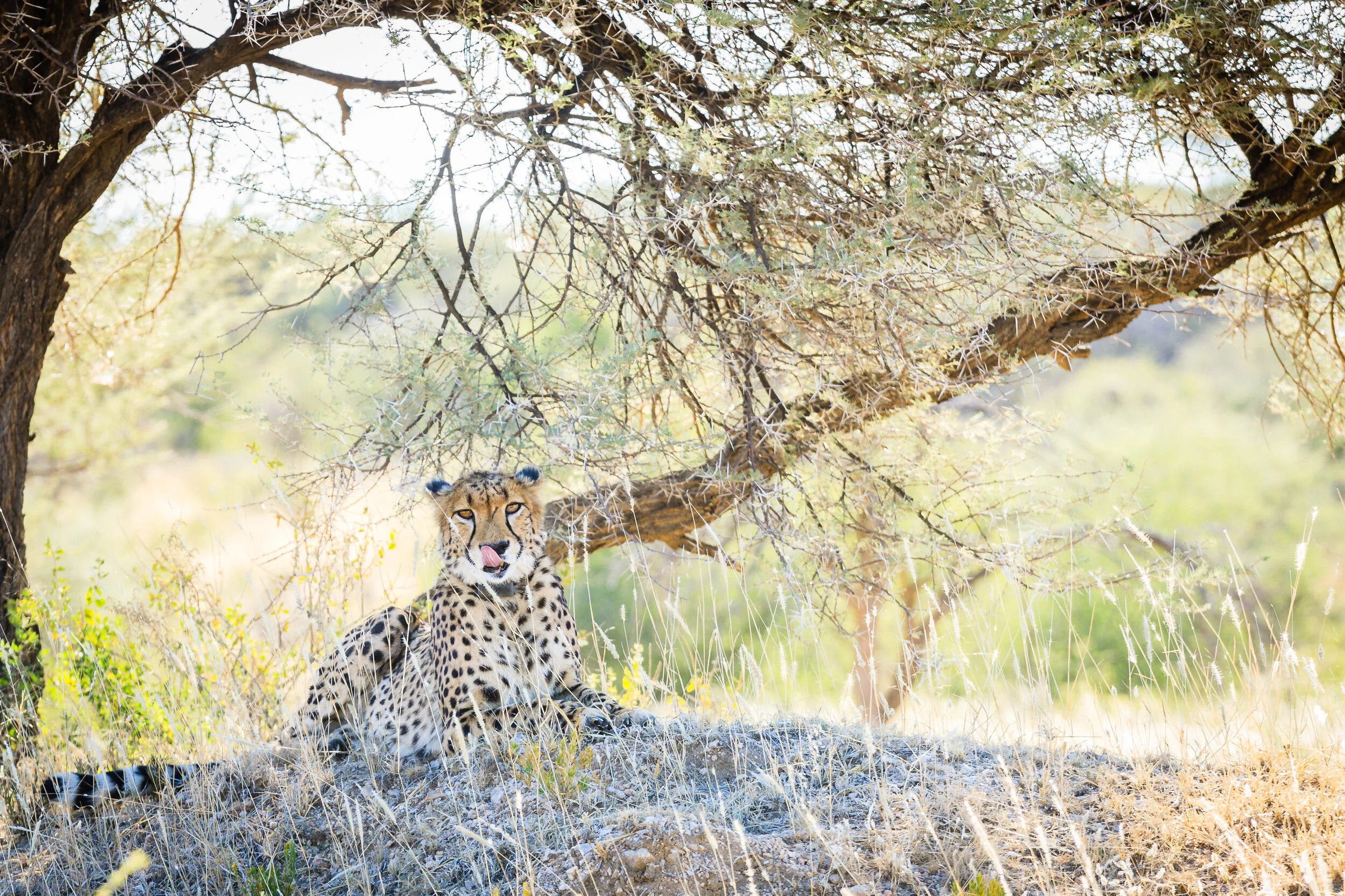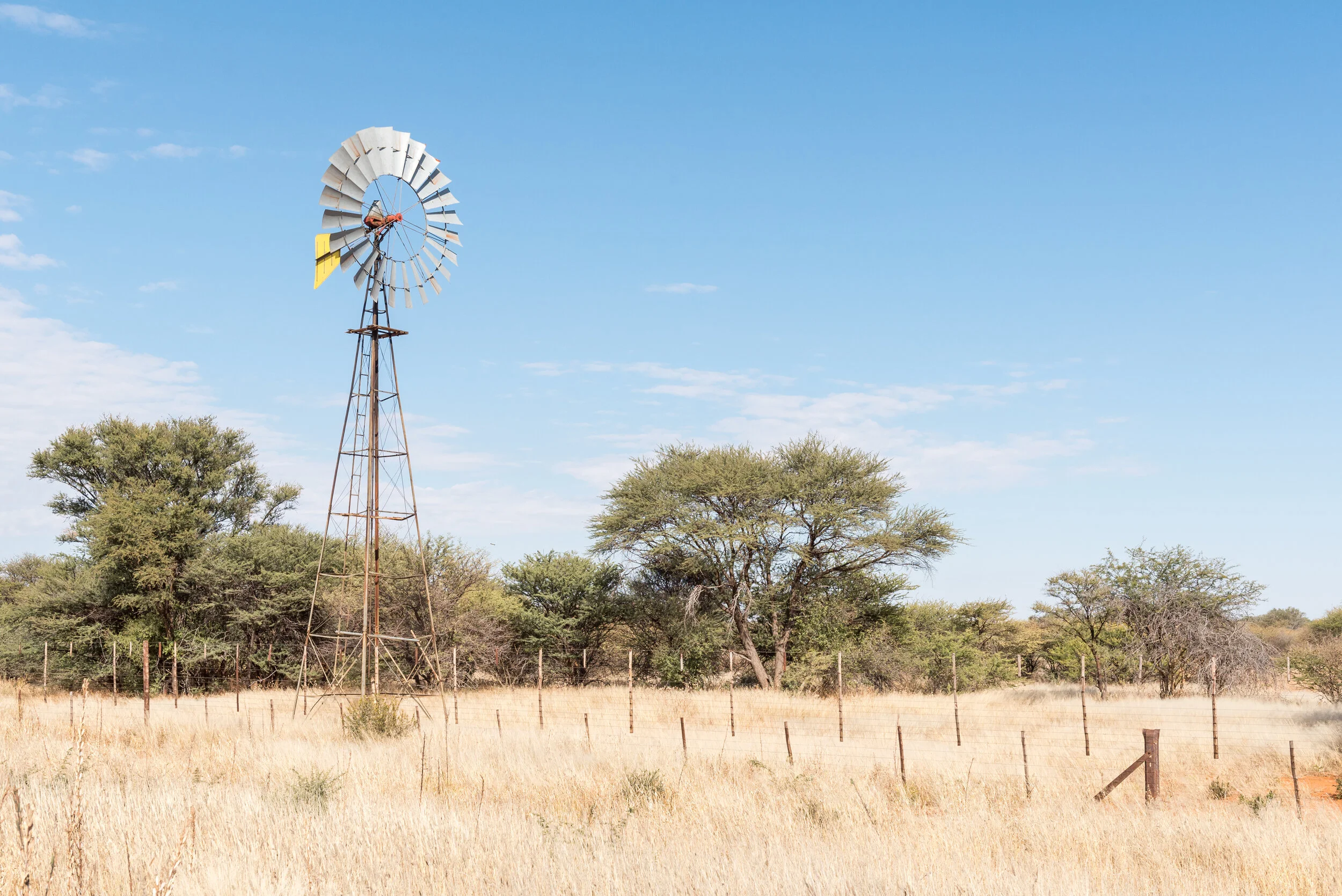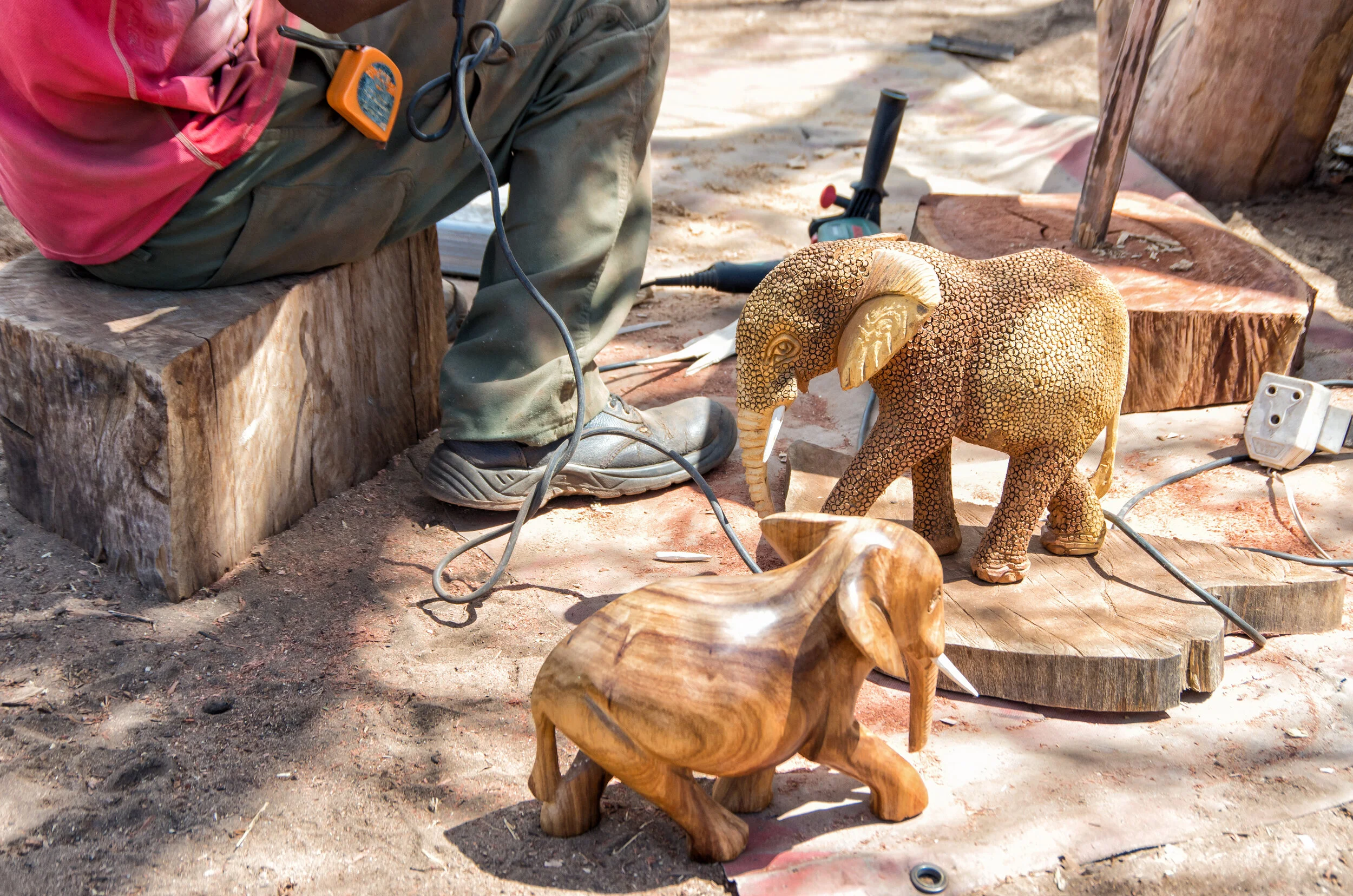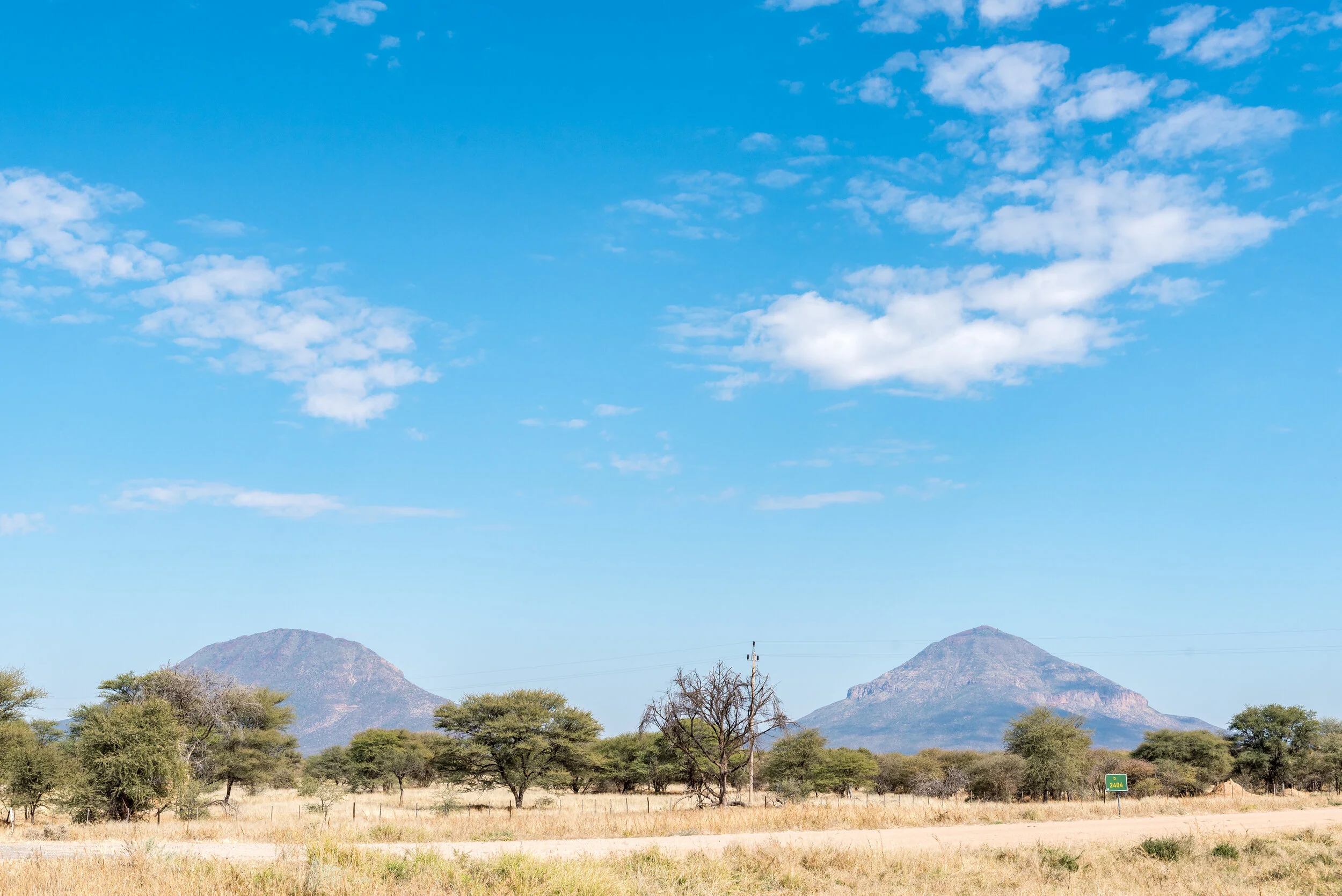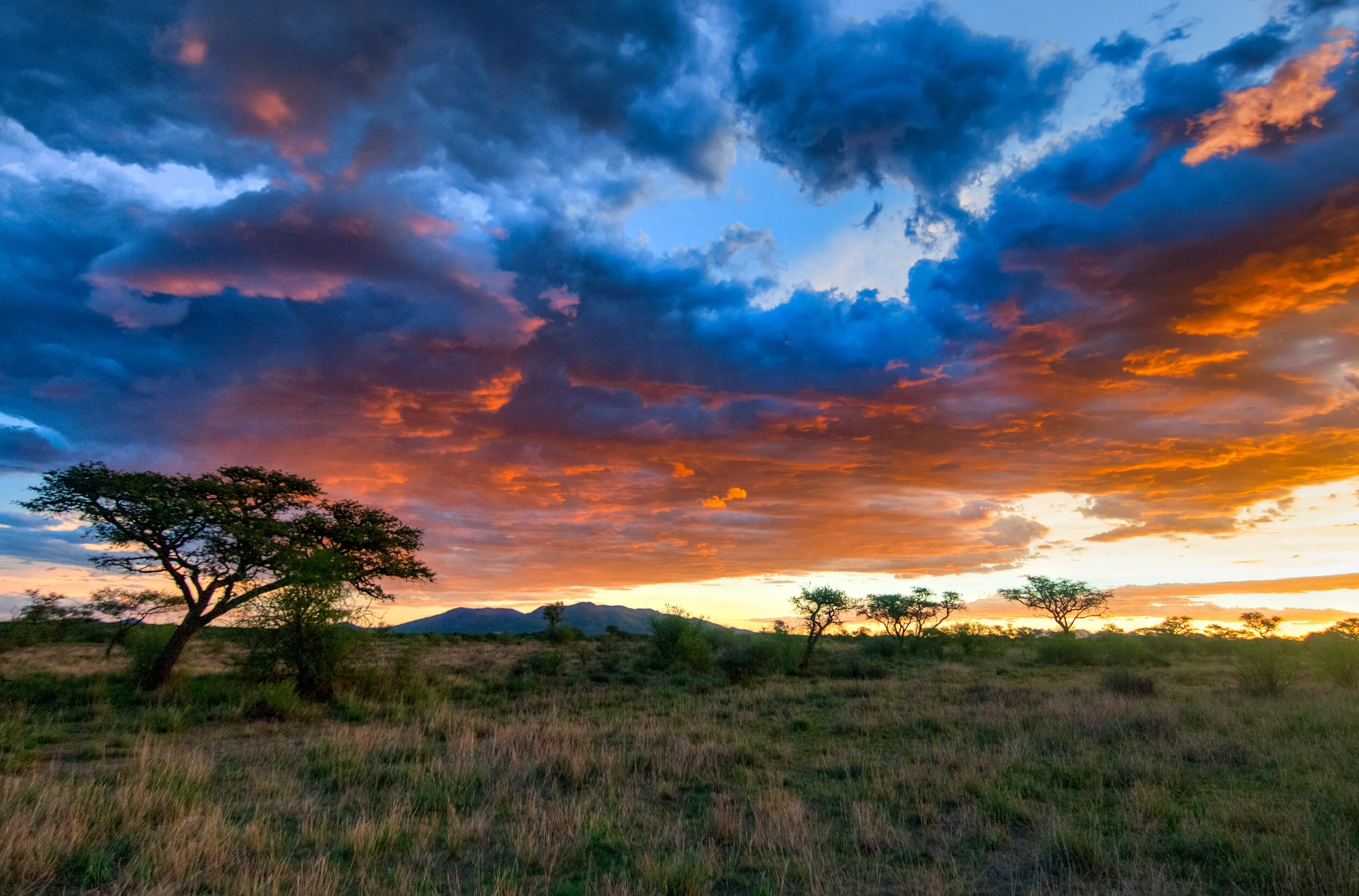Jess’s Namibian Adventure: From Deserts to Eden in 17 Days
Written by Jess Tyrrell
Join me and my fellow traveller, Alessandro, on this voyage of discovery as we explore Namibia's best-kept secrets, from the desert to the Zambezi. Travelling from the vast and magnificent furnace of the Namib Desert, we sought reprieve and greenery in Namibia's hidden Eden. In just 17 days, we experienced the best of Namibia's wildlife and scenery, ticked off the Big 5, hiked through rugged landscapes and enjoyed a gin and tonic or 2 at sunset alongside waterholes and on boats traversing dreamy waterways.
Read on for the highlights of our trip, including our route, accommodation and experiences!
Arrival in Namibia
International flights generally fly into Hosea Kutako International Airport in Windhoek, Namibia's capital city. When we peered out the window close to landing time, we caught ourselves wondering whether the plane got lost above the Sahara! Fret not; we were right on course. Just like a desert oasis, the airport suddenly and inconspicuously appears in the vast arid landscape. In fact, Windhoek is southern Africa's very own Las Vegas: a bustling metropolis rising from an extensive and rocky valley, except it’s much more authentic with way less flashy lights and casinos. Touch down!
Once we had rubbed the sleep out of our eyes and confirmed we weren't dreaming, we got our bags and went in search of a local sim card. Upon entering the arrival hall, there was a MTC shop on the left, and a Telecom Namibia shop on the right. We opted for the MTC shop. A local sim card cost us €0.40 (N$7), and data packages cost about €13.5 (N$235) for 1.5 GB. We planned on topping up our data in towns and at petrol stations, so we didn’t worry about buying too much right from the start.
We decided to download the LEFA app (Windhoek's answer to Uber), available on Google Play and the Apple App Store, to call for a transfer to the city centre. After navigating the pleasant Hosea Kutako International Airport — and revelling in the cool air-conditioned air — we set forth for Namibia2Go in Windhoek to collect our rental 4x4. The drive from Hosea Kutako International Airport to Gondwana’s Namibia2Go Car Rental takes around 35 minutes. We travelled on the winding B6 over undulating hills, surrounded by rocky open plains dotted with thorn trees.
Leg 1: Namibia2Go Car Rental (Windhoek) to Spitzkoppe
After picking up what would be our trusted stead for the rest of our journey, we visited a spaza shop (general dealer) to stock up on some snacks and water for our car trip. The diesel tank was full, so we were ready to hit the wide-open roads!
We left the civilisation of Windhoek trailing behind in the rearview mirror and commandeered onward to the seriously wild and remote Namib Desert. Our destination was a large granite mountain in Damaraland called Spitzkoppe, the "Matterhorn of Africa", a hiking and climbing heaven. The fastest route (3 hours) took us north of Windhoek on the B1 until we reached Okahandja where we took the B2 west towards the Atlantic coastline. The scenery is dramatic. It is a marvel that people and animals persist out here! The rocky, savanna landscapes begin to transform into the sandier and orange-hued desert as we neared the Erongo Region and it was just wide-open space, sand and sunlight! We could feel the unabated sense of freedom setting in. At this point, I'd recommend putting America's "A Horse With No Name" on....
We eventually passed through the small desert town called Usakos, north of which is the dramatic volcanic Erongo mountain range. At Usakos we filled up with diesel, quenched our thirst and purchased the last few items we thought we'd be needing for the next few days. We even filled a jerry can with fuel in case we run out on one of the rural district roads we were bound to encounter (did someone say adventure?!).
From Usakos, we continue on the tarred B2 until the turn off for the D1918. The journey is now on dirt – i.e. we would be driving a lot slower and more carefully! If the roads are very sandy and you feel like your tyres are sinking, let them down slightly, and just remember to repump them when you rejoin a tar road.
Soon after the turnoff, we passed the Uiba Oas Crystal Market. The perfect spot to meet locals and purchase some beautiful precious and semi-precious crystals from the surrounding mountains. With our crystal purchases glistening on the window sill, we continued on the D1918 until the right turn for the D3716. As we approached Spitzkoppe, our jaws hit the floor. We felt like we had landed on Mars! We crossed over the (dry) Spitzkop River until the left turn on the D1925, passing the community-run camp and desert restaurant. On our right was towering Montañas Pontok. We turned right into the gap between Spitzkoppe and Montañas Pontok until we finally reached our one-of-a-kind home for the night: Spitzkoppen Lodge. The boulder-strewn landscape has plentiful activities on offer, including hikes onto the mountains with local guides, open-air restaurants and bars, fossil sites and much more.
We checked into Spitzkoppen Lodge, a family-run low-impact lodge nestled amongst the granite boulders. This exclusive and stylish lodge has breathtaking views of the Brandberg and Erongo Mountains in the distance. There are only 15 en-suite tented chalets, all with private viewing decks. There is also a pool to refresh yourself in as the arid Namib sun beats down on the landscape. We organised several activities from the lodge, such as cycling, horse riding, walks, game drives and bird watching excursions. There is also wifi ;) I will never forget my first sunset or sunrise in Spitzkoppe – the kaleidoscopic array of pink and purple hues cast onto the surrounding rocks left me in awe. We decided to spend 2 days unwinding and welcoming the desert way of life. Very soon on, we had acclimated to the weather and the pace of life in the African desert. I would have gladly never left!
Leg 2: Spitzkoppen Lodge to Camp Kipwe
After 2 days of exploring life among the boulders of Spitzkoppe, we set forth for another desert retreat – Camp Kipwe. This time, in the Twyfelfontein Conservancy in Damaraland, about 223 km northwest of Spitzkoppe. This drive took us along the border of the arid Namib Desert towards Brandberg Mountain and took us around 3.5 hours with stops (so we'd recommend hitting the road after a hearty breakfast and coffee). Exiting Spitzkoppen Lodge from the north, we rejoined the D3716 that we entered on, this time travelling north. We arrived at a T-junction and turned left onto the D1930. There is virtually no civilization along this road, so be prepared for isolation and unreal scenes all to yourself! 93 km from Spitzkoppen Lodge, we eventually reached Uis, the perfect small-town stop to stretch our legs and refill our tummies. I recommend stopping at Cactus & Coffee for a quaint and unique desert dining experience.
Leaving Uis with our bellies and coffee mugs replenished, we turned onto the C36 and then very quickly onto the C35, travelling north (not towards the coast!). We drove past towering Brandberg, Namibia’s tallest peak standing at 2.573 m, and Uisberge mountain ranges into the rocky terrain of the Kunene Region. Just before crossing over the Ugab River, there is a tiny settlement called Ugab with an even more miniature grocery and liquor shop (painted with murals of wild animals). Eventually, we reached the D2162 on the left. Taking this road led us past Madisa and Malansrus Camps, and Khoendi Guestfarm. 8 km after Khoendi Guestfarm, the turnoff for Camp Kipwe was on the left. We were absolutely amazed. It ain't a mirage, simply unadulterated yet understated African luxury!
Camp Kipwe is an intimate and remote bush lodge located in Namibia's arid yet starkly beautiful Twyfelfontein region, home to many ancient Bushman etchings. The 9 specially-designed rooms are unique and private, with outdoor bathrooms, thatched roofs and spectacular views over the surrounding area. Camp Kipwe offers guided nature walks around the Twyfelfontein Conservancy, as well as trips to see the Bushman etchings, the mysterious Organ Pipes and Burnt Mountain. For an extraordinary experience, an Elephant Nature Drive is a must-do; explore the terrain in search of these elusive desert-dwelling elephants who have adapted to the dry and sandy conditions of northern Namibia.
Leg 3: Camp Kipwe to Etosha Safari Lodge
We were sad to leave our nest-like oasis in the heart of Twyfelfontein, but this was short-lived as we had another fantastic spot to experience next! The calls of wild African animals were beckoning, so we made our way east to Namibia's most famous safari destination – Etosha National Park. Trading red rock plains for white salt pans, we carried on along the D2612, passing the Damara Living Museum. This enriching cultural experience is well worth a stop as we learned about the lives of the locals who are experts at living in, and harmoniously with, their arid surroundings. We eventually reached a T-junction where we turned right onto the C39, passing another cultural museum on our left. Continuing on this road we reached the petrified forest 46 km west of Khorixas. We stopped here to check out the remains of enormous trees that have turned to stone!
Leaving the petrified forest behind, we reached the town of Khorixas after 46 km, where we refuelled and restocked before continuing on the C39 inland until Outjo. We opted to take a short detour to see the peculiar “Vingerklip” (Finger rock), the turnoff for which was about 52 km east on the C39. A further 20 km stretch brought us right up to rock where we took a stroll along the marked path.
We returned to the C39 and continued onto Outjo and then onto the C38 headed north, passed the Outjo airport and continued straight for around 1 hour to Andersson Gate, the central/southern gateway to Etosha National Park! Etosha Safari Lodge is located 10 km south of Andersson Gate. The greenery is a vivid contrast to the bygone moonscape we had become accustomed to. At Etosha Safari Lodge, you can sip on a drink while watching the ruby sun dip into the mopane woodland. The lodge is perched on a hill with expansive views and offers 65 chalets that provide a peaceful base from which to explore the animal bounty of Etosha National Park. We woke up bright and early in the mornings to head out to catch the wild inhabitants of Etosha National Park while the temperatures were still cool. We packed a day's worth of snacks and water, field guides, binoculars, cameras and sunblock as we were not planning on coming back for lunch!
There are several waterholes to investigate around the park, all with unique features and animal visitors. We came to expect a great variety of animals at a single waterhole at any given time. No matter what turn we took, or what vista we sought, we were always in for a seriously profound safari experience.
We wish we could see your expression when you visit the desolate white salt pan for the first time; it is a sight to behold, especially considering the animal inhabitants, from rhino to elephants, giraffes and lions, all eke out a living here.
Reminder: be mindful of the gate entry and exit times, but try to catch a sunset at a waterhole (Okaukuejo is quite close to the gate) at least once!
Leg 4: Etosha Safari Lodge to Onguma the Fort
To see the situation in the east, we headed onward to our next, albeit entirely different, safari experience – Onguma the Fort in Onguma Private Nature Reserve (did someone say '"fancy"?!). This breathtaking drive took us across the entire length of the Etosha pan! Think 3 hours of uninterrupted views of wild animals frolicking alongside waterholes, seeking shade and perhaps on the hunt! We entered the park through the Andersson Gate, and continued on the C38 eastward, passing several waterholes featuring a plethora of avian, reptilian and mammalian guests! The salt pan stretches on for as far as the eye can see, and it is quite bright so wear your specs.
Eventually, the road comes to Namutoni (Von Lindequist) Gate, the eastern gateway to the park. We exited the gate (don't be sad as you're in for one hell of a treat at Onguma), turned left and veered right onto the sandy road that took us back to the Etosha salt pan, this time to its north! After crossing the Owambo River, we passed the shaded Onguma campsites and camps. Circling around, we finally arrived at what could only be conceived as a vision brought on by staring too much at the white salt pan. Onguma The Fort is unlike any other, the only one of its kind in Namibia, and it is real!
We enjoyed the life of a royal at this opulent and luxurious bush escape at the intersection of African, Indian and Moroccan-inspired design. 13 suites cater to travellers looking for a slow-paced journey at Onguma The Fort. With one of the best viewpoints of Etosha’s wilderness, we basked in every sunset and sunrise at the magnificent terrace overlooking hundreds of camel thorn trees. We even watched Etosha’s wildlife at a waterhole from the comfort of our room and up-close at the Onkolo Hide! For a little soul-soothing, I opted for a massage and multiple dips in the pool.
Leg 5: Onguma the Fort to Hakusembe River Lodge
After 2 glorious nights here, we bid royal waves to our hosts. The river was calling! Now was time for us to take the Namibian road less travelled, up and away to the lush North, teeming with rivers, woodlands and greenery! Did someone say hippos?
We met up with the B1, driving south towards Tsumeb. Tsumeb, the "gateway to the north" of Namibia, is a vibey little town and a great place to stop for all kinds of supplies. Curious to see only 1 of 2 permanent and natural lakes in Namibia, we stopped at Otjikoto Lake, 21 km before Tsumeb town. “Otjikoto” means deep hole, and it is just that – a sinkhole that reaches 145 m deep. It used to be a cave but the ceiling collapsed, exposing the waterbody underneath!
Hitting the road once again, we took the B1 until it turns into the C42, a road that takes you to Grootfontein (we pay a visit here later). From Grootfontein, we joined the TransCaprivi Highway (also called the B8), a tarred road that joins Namibia, Zambia, Zimbabwe, Angola and Botswana and facilitates travel through the Kavango–Zambezi Transfrontier Conservation Area (KAZA), the largest transnational protected area in the world.
We marvelled at the changing scenery in dramatic contrast to the desert landscapes from the week before! Eventually, we passed Mangetti National Park, a community-run national park teeming with wildlife (I took a mental note to explore it in the future). We soon arrived at the northern tip of Namibia at its border with Angola! Rundu is the largest town in the Kavango Region and is located on the Cubango/Kavango River. There are plenty of shops to gather the necessary supplies, and the beautiful woodwork on display that the famous woodcarvers from this region make are also a treat. Leaving Rundu behind, we headed northwest on the B10, turning right onto the Zufahrt Hakusembe River Road towards the river.
Can you hear and smell the water? What about the sounds of cooing birds and the rumble of hungry elephants? We passed over waterways and wetlands, the dry interior of Namibia a distant memory. The oasis that lay before us was unexpected and completely underrated. It is quite simply spectacular. Just before Hakusembe River Lodge, there is the Mbumza Living Village, where we stopped to learn about the customs and traditions of the local people.
Where does the road less travelled end, you ask? At the river's edge, and wow, was it enticing—a lush green oasis on the banks of the Kavango River. We absorbed the river peace from one of the 20 chalets, hopped aboard the Hakusembe River Queen come sunset, strolled to the nearby cultural village and relaxed on the deck listening to the soft symphony of feathered friends. This is the perfect midway stop to unwind, take a breath and relax!
Leg 6: Hakusembe River Lodge to Nambwa Tented Lodge
Our natural alarm clocks - the sunrise chirps of endemic birds - softly alerted us to our surroundings. Life on the river is good! And it only gets better. After breakfast, we set out for the 5-hour drive into Namibia's Zambezi Region (AKA, Eden). Driving the length of the Kavango River, the same river that flows into the Okavango Delta in Botswana, we passed local villagers living amidst farmlands and woodlands. After 2 and a bit hours, we reached Divundu, the gateway to the Kavango and Zambezi Regions. We continued on the B8 over the Kavango/Cubango River in hot pursuit of green pastures. Bwabwata National Park stretches over much of this area, leading to some confusion with Google Maps. We were travelling to the Kwando Core section of the park in the far east at its border with the Kwando River, not the Bwabwata National Park entrance near Divundu.
After another 2 hours, there was a sign and turnoff for Bwabwata National Park – Kwando Core Area – on the right. This is where our hosts for the night were to be discovered! If you pass over the Kwando River, you have gone too far. Once we paid the entrance fee at the park station and grabbed some paper maps and educational material on the area (trust me, you need these), we let our tyres down in preparation for the sandy (and flooded) roads ahead!
We followed the sandy and curved road along the Kwando River south for around 14 km from the entrance gate, opting to take detours that took us right to the water edge of the wetland system. We then arrived at Nambwa Island where we were welcomed into a dreamlike African treehouse by friendly hosts and shown to our very own palace. In the afternoon, we were treated to a herd of resident elephants that came to snack on the tree pods just beneath the wooden walkway. We could make out individual eyelashes, see the intricate wrinkle patterns in their thick skins and hear their grumbling stomachs. The Lodge offers 10 luxurious tents nestled high in the majestic jackalberry, sausage and knobthorn trees. The decadently spacious tented suites open completely and emanate a feeling of vastness. From the privacy of our large open-air deck, we watched the sky illuminate with hues of purple and amber and felt re-energised for the adventures ahead. We went on sunset game drives and boat cruises to lap up the wild and green way of Namibian life, from hippo-teeming rivers to river banks bustling with buffaloes. This is where we completed our Big 5 list, and saw more animals than anywhere else in Namibia!
Our lives had become synchronised to the peaceful ebb and flow of the tranquil waterways. These rivers and their surroundings are bountiful, both with human life and of the animal kind! There are numerous cultural villages and craft centres to purchase beautiful handmade souvenirs or learn a thing or 2 about the local customs. Many of the conservancy members are also involved in tourism in the region, greatly contributing to the local economy and standard of living of locals.
Leg 7: Nambwa Tented Lodge to Divava Okavango Resort & Spa
We said our goodbyes to the woodlands and floodplains of Nambwa Tented Lodge and headed west back to Divundu. Just after crossing the Cubango/Kavango River, a left turn took us onto a road that follows the river course to a meander in the river. We passed Popa Falls Resort, an excellent stop for views of the calming rapids of Popa Falls before reaching Divava Okavango Resort & Spa, located on the banks of the life-offering river. After such an exhilarating journey, I visited the Divava Okavango Spa, a place that evokes the perfect harmony between natural beauty and pure relaxation. All 20 thatched rooms are in the tranquil gardens, and we enjoyed delicious meals at the onsite restaurant. The Resort offers an exquisite view over the Okavango River with excellent opportunities for bird watching and other activities for us young and curious explorers.
Leg 8: Divava Okavango Resort & Spa to Fiume Lodge
We left our zen-like retreat for the rugged and arid interiors once again. The TransCaprivi Highway landed us smack bang in the middle of Grootfontein, an agricultural town with the world's largest intact meteorite, the Hoba meteorite! 35 km before Grootfontein, and 3 km off the B8 is Fiume Lodge and Game Farm, a family-owned 14.000 ha private game farm home to giraffe, eland, oryx, zebra and us (for the night!). This comfortable and grassy lodge fits a whole family with 9 stylish en-suite chalets with a view of the beautiful garden and its big lawn. We went on a 2.5-hour sundowner drive filled with sightings of mammals, small and big, as well as snacks and refreshing drinks. We even opted to experience a day in the life of a farmer, where we accompanied the farmer on his daily errands. If you're feeling super adventurous, you can head to Mangetti or Khaudum National Parks for a game drive where, if you’re lucky, you could spot African wild dogs!
Leg 9: Fiume Lodge to Okakeua Farmstay
Keeping with the family spirit of this end of the trip, we moved on from Fiume Lodge to stay at Okakeua Farmstay. An easy-going 3 hour and 15-minute drive got us there. We travelled through Grootfontein on the B8 up until Otavi, then southwards on the B1 through Otjiwarongo, finally turning off onto the D2404 and D2475 until arriving at home sweet home. En route, we visited the Okonjima Nature Reserve, a large scenic reserve with abundant wildlife home to the AfriCat Foundation. There are several rescued big cats and predators to see here, like cheetahs, hyenas and leopards. We went on a game drive through the acacia scrub, went on a hike, bird watched and enjoyed sundowners before retreating to our quiet and rural farm stay. Here we indulged in delicious homemade meals at the restaurant, went for cooling swims and learned about sustainable farming practices.
Leg 10: Okakeua Farmstay to Windhoek Airport
On our last morning in Namibia, we headed south to Okahandja along the D2180 and B1. Also called Namibia's "garden town", Okahandja is the historic capital of Herero people. The Okahandja Mbangura Woodcarvers Craft Market is a great craft market where artists from the surrounding regions sell their crafts. It is the perfect place to pick up souvenirs before heading south for Windhoek! The drive from Okakeua Farmstay to Okahandja took around 50 minutes, and it took us another hour and 30 minutes to get to Hosea Kutako International Airport on the B1 and B6, through Windhoek. Our flight was is in the evening, so we did some sightseeing in town before making the winding journey.
And just like that, my 17-day dream trip to Namibia had come to a bittersweet end. The variety of sights, sounds, smells and tastes we experienced were incomparable to any adventure we’d had before. Namibia is the land of unparalleled and unexpected scenery and did not stop treating us with its earthly delights. It is welcoming and freeing, and a destination I hold close to my heart. These untouched regions of Namibia are yet to host their full potential of tourists, and this is the beauty of it. Its very fabric is built on sustainable and responsible tourism, all without compromising on luxury, safety or making memories. It will steal your heart, we promise.
If taking the path less travelled tickles your fancy, this tour will reward you handsomely along the way. Viatu offers this trip as our Deserts to Eden in 17 Days, and it is customisable! Go on, venture into the unknown…

